Quality of the Environment in Japan 1994
(8) Carbon Dioxide and Other Greenhouse Gases
The issue of global warming refers to problems associated with various influences such as the rising sea level, changes in precipitation patterns, and changes in natural ecological systems. These influences are induced by the increase of global mean temperature, due to the growing atmospheric concentrations of greenhouse gases emitted by various kinds of human activities.
Greenhouse gases such as carbon dioxide (CO2), methane (CH4), nitrogen dioxide (N2O), and chlorofluorocarbons (CFCs) absorb the infrared rays emitted from the surface of the earth warmed by solar radiation and reemit them, making it difficult for heat to escape into space by warming of the surface and the atmosphere. This causes the temperature of the atmosphere and surface to become warmer than without the greenhouse gases and this maintained temperature is appropriate for the existence of biological creatures. However, it is known that increasing concentrations of greenhouse gases are causing temperatures to rise at a rate that mankind has never before experienced.
In addition, aerosols in the atmosphere originated in phenomena such as volcanic eruptions may reflect or absorb solar radiation, thus affecting the climate.
According to a report released by the Intergovernmental Panel on Climate Change (IPCC), a panel established in 1988 jointly by the World Meteorological Organization (WMO) and the United Nations Environment Program (UNEP), the contribution of CO2 among greenhouse gases in the 1980s was about 55%. Although methane and other substances have much greater global warming potential per unit volume, the volume of emissions of CO2 is so large that CO2 is thought to be a major contributor to global warming (Figure 4-1-20).
Fig. 4-1-20 Proportioins of Greenhouse Gases Derived from Human Activities in the 1980s that Contributed to Global Warming
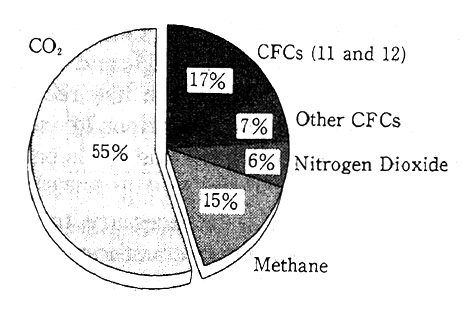
Source:IPCC report
Prior to the Industrial Revolution, the concentration of CO2 in the atmosphere was around 280 ppm. At present, the concentration is over 350 ppm and is estimated to be increasing at the rate of 0.5% per year (Figure 4-1-21). The total volume of greenhouse gases in the atmosphere in the 1,000 years prior to the Industrial Revolution was relatively stable. Now, however, the total volume of greenhouse gases is rising sharply due to the growth of industry and agriculture worldwide associated with the increase in the world's population. The combustion of fossil fuels and the reduction in forests is thought to have caused an increase of 26% in the concentration of CO2 in the atmosphere. According to domestic observations carried out at Ryori in Sanriku town, Iwate Prefecture, and other locations, the average annual concentration of CO2 in 1993 was 359.3 ppm.
Fig. 4-1-21 Trends in Concentrations of CO2, CH4, NO2, and CFC-11
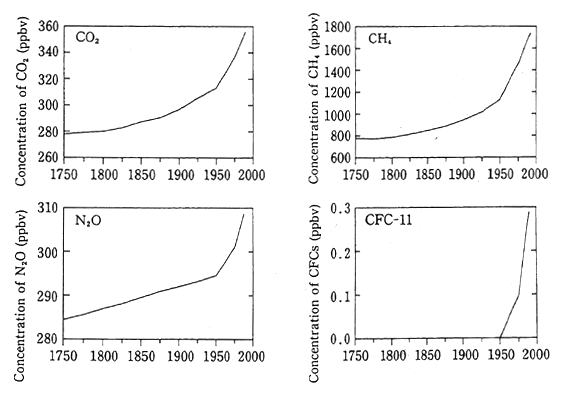
Source : IPCC report
It is reported that the increase in greenhouse gases, assuming that no countermeasures are taken, will cause a rise of about 1 degree C in the average global temperature, compared with the present, by the year 2025, and by the end of the 21st century, the rise could be about 3 degree C. Under these conditions, it is also reported that the sea level would rise by about 20 cm from the present level by the year 2030 and by about 65cm (maximum 1m) by the end of the 21st century. It is indicated that drying and other negative effects, depending on the region, would accompany changes in climate (Figure 4-1-22).
In the framework of a 100-year time scale, CH4 (methane) is thought to have a greenhouse gas effect about 21 times as severe as that of the same volume of CO2. Methane is produced by natural sources such as wetlands and swamps and leaks of natural gas and by man-made sources such as the farming of domestic animals and the decomposition of rice paddies and waste materials in landfills.
According to analyses of the atmosphere over the past 3,000 years, the concentration of CH4 was more or less stable up to about 250 years ago. However, it is estimated to have more than doubled during the past 200 years. Observations are being carried out at Ryori, Sanriku town, in Iwate Prefecture. The average concentration in 1993 was 1.82 ppm. The atmosphere over Siberia has been found to contain high concentrations of CH4, and the swampy regions of Siberia are receiving attention for their role as a large natural storage of CH4.
Considering NO2 in the framework of a 100-year time scale, NO2 is thought to have about 290 times the greenhouse effect of CO2. Besides such natural sources as oceans and soils, man-made sources of NO2 include the combustion of such biomass as fossil fuels and wood and the fertilization of agricultural land. Although NO2 is known to have a long atmospheric life of 150 years, little is known about its behavior and effects on a global scale. According to the IPCC report, the average concentration of NO2 in 1990 was about 310 ppb (parts per billion). According to observations at Ryori, Sanriku town, in Iwate Prefecture, the average concentration in 1993 was 308 ppb.
Ozone in the troposphere is thought to have a relatively strong greenhouse effect compared with carbon dioxide. It is known that tropospheric ozone is produced by a chemical reaction between NOx emitted by automobiles and factories and nonmethane hydrocarbons (NMHCs), but it is difficult at present to quantify changes based on current observations. It will be necessary to build up scientific knowledge in this area. In addition, ozone in the troposphere not only has a direct greenhouse effect, like CO2 and CH4, on the infrared radiation
Fig. 4-1-22 Predicted Changes in Volumes of Effluent Discharged by Rivers in the Asian Region As a Result of Global Warming
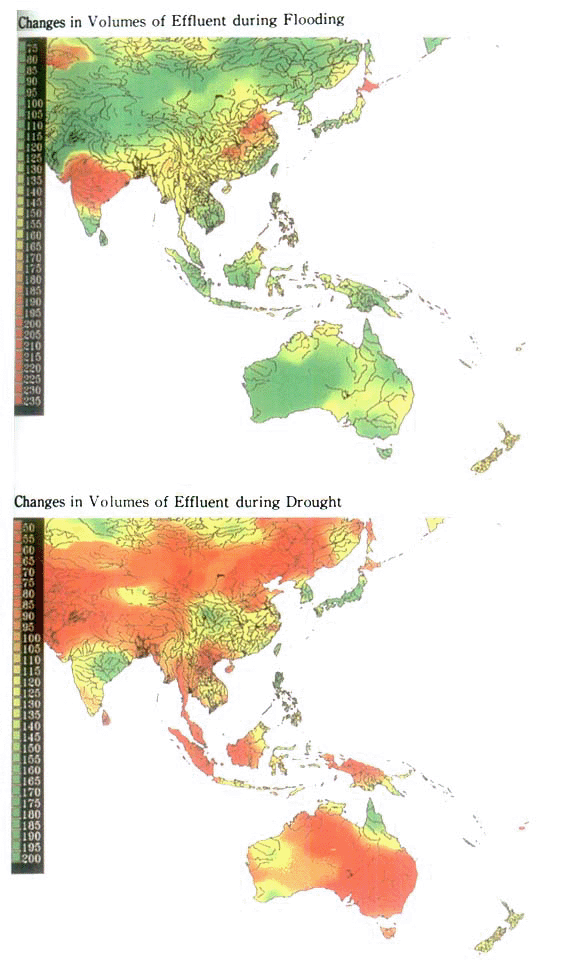
Note : Presented are sample forecasts of changes in the volumes of effluent discharged by rivers under the probability of flood and drought once every 10 years the concentration of atmospheric CO2 doubles. In the diagram at the top, the red-shaded areas show the regions in which the volumes of effluent may double at times of flood, indicating high potential risks of flood damage in the middle regions of India, the eastern region of china, and in Hiokkaido. In th lower diagram, the red-shaded areas show the regions in which the volumes of effluent may halve in times of drought, indicating high potential risks of drought damage throughout the Asian region.
Source: Diagrams created by Assistant Professor Yuzuru Matsuoka of Kyoto University and the National Institute for Environmental Research reflected from the earth, it also contributes directly to the greenhouse effect through its effects on the life of greenhouse gases and by producing gases with the greenhouse effect such as ozone in the troposphere and sulfuric acid aerosols. As such, tropospheric ozone may play a major role in the warming of the atmosphere and of the earth.
Fig. 4-2-10 The present situation of the springs in the Tokyo Region
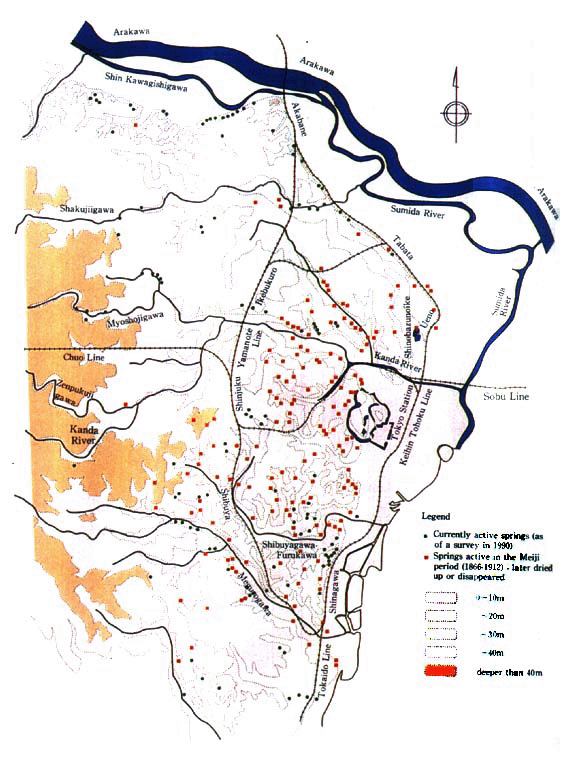
Source: Shimano Genzu, "Report of investigation of Underground Water" Bureau of Environmental Protection, Tokyo Metropolitan Government (September 1992) "Tokyo Waterfront Environment Preservation Plan"
Source : Tokyo Municipal Environmental Protection Wetlands
Fig. 4-5-15 Soil Degradation Severity in Susceptible Drylands
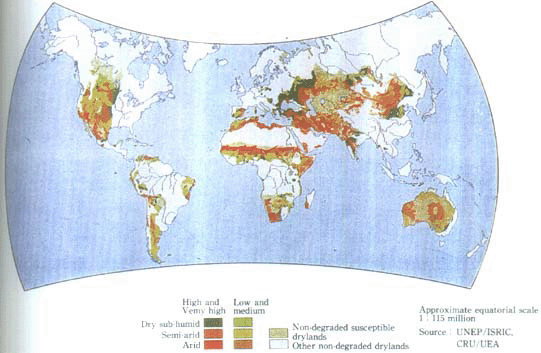
Source: UNEP, World Atlas of Desertification
A scene of star Watching
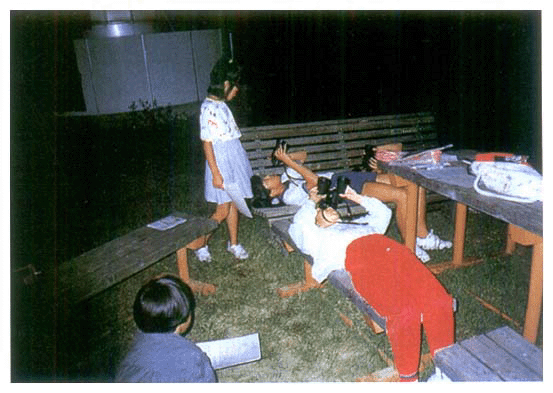
Cypripedium macranthum SW. var rebunense (National Endangered species)
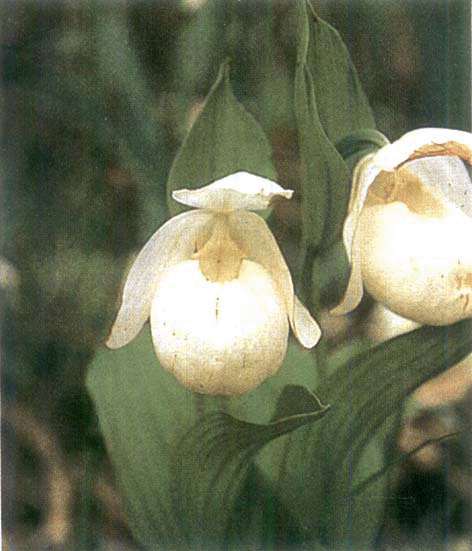
Kakitagawa Springs (Shizuoka Prefecture) -One of the 100 exquisite water of Japan
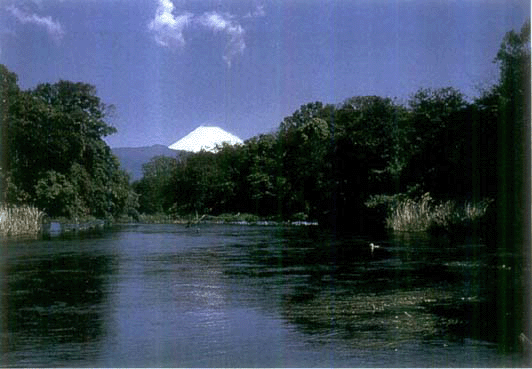
Japan is undertaking a wide range of countermeasures, based on the Action Program to Arrest Global Warming.
And, as the international approach to arrest global warming, the Framework Convention on Climate Change was adopted in May 1992, and it entered into force on March 21, 1994.
(9) Acid Deposition
Acid deposition is the product of SOx and NOx, substances emitted in great volume by mankind's combustion of fossil fuels in factories and automobiles. SOx and NOx undergo chemical reactions in the atmosphere to produce sulfuric and nitric acids, ions of which mingle with water vapor to be precipitated as rain with a pH of 5.6 or less. The term acid deposition can also include acid snow and acid fog, depending on atmospheric conditions. It has long been recognized in Europe and the United States that acid deposition damages such ecological systems as forests, lakes, and marshes as well as precious cultural treasures and other man-made objects. Because of the global scale of the destruction, acid deposition is attracting much attention worldwide.
Acid deposition's effects are felt worldwide, particularly in Europe, North America, and China. A decline in the pH of lakes and marshes can lead to the elution of toxic metals from lake bottoms, killing fish and causing other damage to ecological systems and eventually turning bodies of water into "dead lakes." For example, fish have disappeared from approximately 4,500 lakes and marshes in Sweden and 2,650 in Norway, and in Canada about 4,000 lakes and marshes have been declared "dead bodies of water." In the Rocky Mountain chain and elsewhere in the United States, there are fears that more than twothirds of all lakes and marshes may be acidulated. It is thought that lakes and marshes in Japan as well may suffer the effects of acid deposition.
The effecfs of acid deposition are widespread in Europe, as is evident in the damage to Germany's Schwarzwald (Black Forest) and the Alps. In China, about 87% of the cedars on Omei Mountain, in Sichuan Province, have suffered damage from acid deposition (Figure 4-1-23). However, acid deposition alone is not entirely responsible for damage to forests ; it is thought that other complex interactions among sulfuric acid, nitric acid, other atmospheric pollutants, and ozone also contribute. In addition to harming ecologies, acid deposition has had negative effects on important cultural treasures such as the Parthenon in Greece and Roman ruins.
Fig. 4-1-23 Damage to Forests from Acid Deposition and Atmospheric Pollutants (1988)
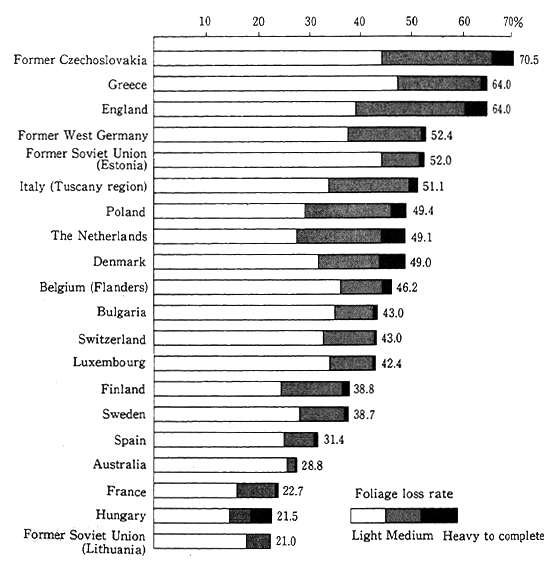
Source : Prepared from UNECE materiais
In Japan, two surveys to determine the extent and effects of acid deposition were conducted. The first survey took place from fiscal 1983 to 1987, and the second survey took place from fiscal 1988 to 1992.
Fig. 4-1-24 Severity of Acid Deposition (Second Survey of Acid Deposition)
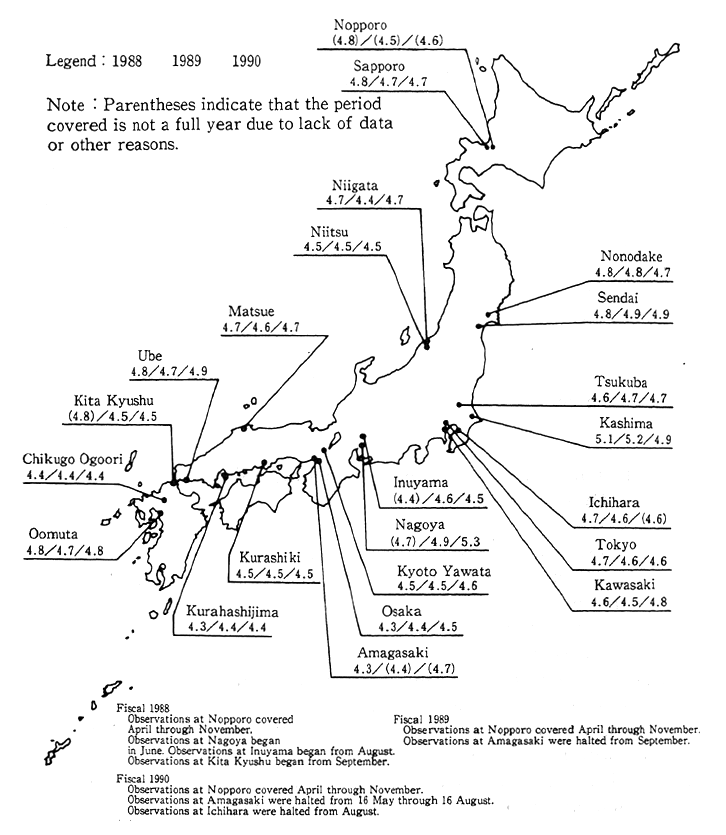
Note : Parentheses indicate that the period covered is not a full year due to lack of data or other reasons.
Source : Environment Agency
Although the second survey found no marked change in precipitation pH levels compared to the first, the annual average pH of precipitation was within the 4.5-5.8 range. In Japan, acid deposition levels were observed to be about the same as those of Europe and the United States (Figure 4-1-24). Japan established 14 national acid deposition observation sites in fiscal 1993 as part of a program to set up an acid deposition monitoring network. If precipitation continues to display high pH levels, it is feared that ecological systems may be negatively effected.
Much remains unknown about the long-term effects of acid deposition on bodies of water, soil, and plants, and more study, research, and monitoring are necessary. The third survey of acid deposition commenced in fiscal 1993.
Acid deposition is a multinational environmental issue as its effects are felt over broad areas and may cross national borders, causing great damage to other countries. As mentioned previously, Europe and North America led in setting up monitoring networks based on the Vienna Convention (Vienna Convention for the Protection of the Ozone Layer). The use of fossil fuels is increasing in East Asia, particularly in China, prompting increasing concern about acid deposition. In October 1993, Japan hosted the First Expert Meeting on Acid Precipitation, which was attended by representatives from East Asian countries, and is taking other steps to establish an East Asian acid deposition monitoring network.
4-1-3 The Status of Noise Pollution, Vibration, and Offensive Odors
Noise pollution, vibration, and offensive odors are matters that directly affect the quality of life and, thus, are significant issues.
Because there has been little success in attaining environmental quality standards in regard to traffic noise, the Central Environment Council is working to frame a comprehensive package of policies, including stronger countermeasures against owners of vehicles that violate regulations and a full range of noise reduction policies relating to traffic, road construction, and roadsides. Policies will be implemented in line with the conclusions of the conference.
The conference is also working to apply appropriate regulatory provisions by adding to the list of substances subject to regulation under the Offensive Odor Control Law, establishing regulatory standards for effluents, and considering expanding the number of facilities subject to regulation under the Noise Regulation Law and the Vibration Regulation Law.
In addition, efforts are being made to secure better living conditions by promoting model initiatives to guide the establishment of environmental policies on offensive odors and noise pollution.
(1O)Noise and Vibration
Noise, which directly stimulates the human sensory organs, can disrupt our daily lives. Noise pollution is generally associated with factories and workshops, construction, and traffic; however, sources of noise are growing in diversity with the progress of urbanization and changing lifestyles.
As a result, complaints are increasing about ambient noise, such as that produced by household appliances and from late-night business operations.
Among the pollution-related complaints received by local public bodies, complaints about noise are the most numerous. In Japan, the total number of complaints made in fiscal 1992 was 15,539. This figure represents a decline of about 7.5% from the 16,800 complaints made in fiscal 1991 and a decline of about 64% from the record number of complaints made in fiscal 1973. Noise tops the list among the seven typical pollution-related complaints and, along with vibration, accounts for about 40% of such complaints. As such, controlling noise and vibration are important issues in improving the quality of life (Figure 4-1-25). Broken down by source, factories and workshops are implicated in 5,764 of the complaints, accounting for nearly one-fourth of total complaints. This is followed by construction operations, which are implicated in 2,737 complaints, and late-night business operations, which are implicated in 1,659 complaints. Nearby noise caused by late-night business operations, amplifiers, and neighboring households accounted for 5,985 complaints. A review of trends during recent years shows that while the total number of complaints, including noise from factories and workshops and construction operations, is declining, noise generated by households remains by and large unchanged.
Fig. 4-1-25 Trends in Complaints Filed by Pollution Category
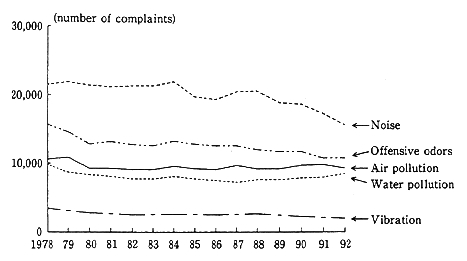
Source : Environmental Dispute Coordination Commission
A variety of countermeasures are thus being undertaken. These include the establishment of environmental quality standards classified according to property zoning and the times when typical sources of noise are active. Such standards cover general residential environments, vehicle traffic, aircraft, and Shinkansen high-speed rail transportation. In addition, regulatory standards have been established for noise generated by factories and workshops, construction, and vehicles.
In regard to noise generated by vehicle traffic, Japan has established environmental quality standards that vary according to time of day-morning, afternoon, evening, and night-depending on the local zoning and number of traffic lanes. Nonetheless, the proportion of observation points, particularly in large cities, that do not record compliance with environmental quality standards is relatively large.
Of 4,511 observation points throughout Japan, 3,943 locations (87. 4%) recorded levels that were above environmental quality standards for vehicle traffic noise in 1992. Moreover, 2,462 of these 4,511 observation points (54.6%) recorded excessive levels during all four time segments. A further 1,481 of the observation points (32.8%) failed to record acceptable levels during at least one of the four time segments. The proportion of observation points in large urban areas (Tokyo's 23 wards and 12 government-designated cities) that recorded excessive levels during all four time segments was 72.3%. The proportion of observation points in other areas recording unacceptable levels during all four time segments was 51.7%, which is still relatively high (Figure 4-1-26).
Fig. 4-1-26 Attainment of the Environmental Quality Standards in Large Urban Regions and Other Areas

Source : Environment Agency
A simple comparison is impossible because the periods and times of observation differ according to the time of year. However, an examination of records kept by 1,200 observing points that collected data over the five-year period from 1988 through 1992 shows that the proportion of locations that recorded unacceptable levels in all or at least one of the four time segments rose from 88.2% in year three to 89.4% in year four of the period. Moreover, an examination of the entire five-year period reveals an ongoing rise in noise levels (Figure 4-1-27).
Fig. 4-1-27 Trends in Environmental Quality at Observation Points that Conducted Continuous Monitoring
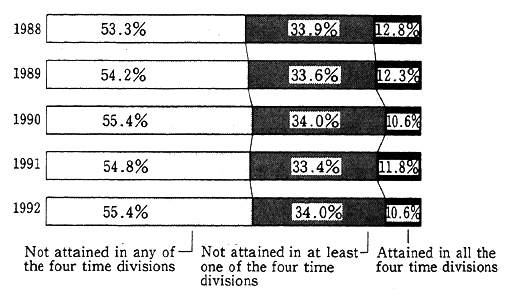
Source : Environment Agency
Local authorities may request that local public safety committees extend the limits set under the Noise Regulation Law. The extensions of limits on requested standards range, depending on the area and time segment, from 5 to 15 dB (decibels). An examination of data from observation points that recorded levels exceeding requested limits shows that 1,416 (31.4%) of 4,511 locations nationwide exceed recorded higher levels. Of these locations, 126 (2.8%) recorded excessive levels in all four time segments and 1,290 locations (28.6%) did so in at least one time segment. A breakdown by region shows that the proportion of observation points where requested limits were exceeded was 39.7% in large cities, as opposed to 30.1% in other areas. An examination of this trend, as recorded at observation points that maintained continuous observations over a five-year period, shows that the proportion of locations where limits were exceeded rose slightly, from 32.7% in 1991 to 33.2% in 1992. Moreover, general noise levels continued to rise during the five-year period.
To reduce traffic noise, Japan has been tightening regulations applying to multiple violators, but the attainment of environmental quality standards along main roadways remains spotty. The imposition of comprehensive countermeasures will be necessary in the future.
The government is implementing a variety of countermeasures against noise generated by aircraft, including the introduction of quieter aircraft and noise controls in the vicinity of airports. Although there is a trend toward overall improvement at such major airports as those in Tokyo, Osaka, and Fukuoka, there has been little improvement since the time when environmental quality standards for noise were first imposed and the number of airports nationwide that meet these standards remains small. As domestic airports come under increasingly tighter control, they will need to pay greater attention to environmental protection and step up efforts to attain environmental quality standards.
Turning to the noise caused by Japan's Shinkansen, it is recognized that countermeasures have resulted in great improvement, although a great many areas still fail to meet environmental quality standards. A policy to reduce noise by the end of 1993 below 75 dB was applied where the Tokaido and Sanyo Shinkansen pass through heavily concentrated residential areas and in similar areas along the tracks of the Tohoku and Joetsu Shinkansen. A survey to ascertain the extent to which this policy has been successful will be undertaken in fiscal 1994. In addition to the noise and vibration from the Shinkansen, noise and vibration from conventional railroads have prompted complaints. As a result, the government is introducing a variety of countermeasures to reduce noise pollution associated with the Tsugaru Straits Line and the opening of the Seto-Ohashi Line.
New governmental organizations have been formed at the national and local levels to deal aggressively with noise pollution in cities. This involves confronting noise pollution associated with urban life, such as that from pets, loudspeakers, karaoke, and musical instruments as well as vehicles.
Complaints concerning vibration numbered 2,193 in fiscal 1992, about the same as in the preceding fiscal year (2,207) and representing a decline of about 47% from their peak in 1973. An examination of the number of complaints in recent years shows an overall downward trend. Although complaints about vibration from factories and workshops and construction are declining, complaints about vibration from road and rail traffic are showing a slight uptrend. By administrative district, Tokyo registered 571 complaints, followed by Osaka with 217, and Nara with 209. These three administrative districts accounted for about 45% of total complaints.
(11) Offensive Odors
Offensive odors pose a problem closely related to everyday life. Because even extremely small amounts of certain odor-causing substances may be perceived by people as unpleasant or offensive when introduced into the air, odors can be considered a type of pollution.
In fiscal 1992, the number of complaints concerning offensive odors amounted to 10,753, a modest increase over the 10,616 complaints registered in the previous fiscal year but lower than the peak recorded in fiscal 1972. In the number of complaints concerning the seven typical pollution-related categories, offensive odors rank second, after noise. By administrative district, Tokyo was first in number of complaints received, with 1,099, followed by Aichi Prefecture, with 912 complaints, and Osaka, with 734 complaints. These three administrative districts accounted for about one-fourth of all complaints. Broken down by source, the service and other sectors that fall in the urban category of offensive odors were responsible for 2,546 complaints (23.7%), followed by agriculture and livestock raising with 2,415 complaints (22.5%). The manufacturing sector as a whole accounted for 2,752 complaints (25.6%), a decline in both number and percentage from the previous fiscal year, Odors emanating from private housing, apartments, and dormitories accounted for 1,279 complaints (11.9%). An examination of the trends over time reveals that while complaints related to agriculture and livestock raising are declining, complaints citing the service sector, housing, and other urban- or lifestyle-related sources are on the rise.
The Offensive Odor Control Law was enacted to contribute to the quality of life and to maintain people's health. The law designates certain substances as the causes of offensive odors and establishes regulated zones and standards for regulating the emission or discharge of offensive odor-causing substances from factories or workshops. In addition, the law makes the observation of regulatory standards an obligation for operators of businesses that emit such substances and allows for the issuance of orders and recommendations that will improve conditions.
4-2 Water Quality
For the most part in Japan, pollution due to toxic substances has been ameliorated remarkably, almost to the levels that the Environment Quality Standards (EQS) achieved. Some toxic substances which are not included under EQS are still slightly detected from water, sediment, and so on.
Concerning organic pollution, EQS has not been achieved in 25% of the water areas in Japan, especially rivers in urban areas and enclosed water such as lakes, reservoirs, inland seas, and bays. Moreover, organic solvents and nitrate nitrogen are still detected in ground water. The environmental amenities around water areas are degrading.
(1) Heavy Metals and Organic Chemicals
The findings of surveys on the water quality in public water areas in fiscal 1992 indicate that the rate of failure to satisfy environmental quality standards for all health items (the rate of samples in excess of environmental quality standards to the total of samples in the survey) came to 0.01%, leveling off in recent years. The ratio stood at 0.63% in fiscal 1971 and 0.28% in fiscal 1972 (Figure 4-2-1), but much im provement has been made thanks to the strengthening and comprehensive orientation of controls and the implementation of projects for the prevention of mining pollution. The rate of trichloroethylene and other items which exceeded environmental target values for water came to 0. 02% in fiscal 1992 (0.04% in fiscal 1990), virtually leveling off.
According to a 1992 survey that was designed to discover chemical residues in the general environment and determine their concentrations, 8 substances of the 17 studied in the survey were detected in water; none, however, were found in sufficient concentrations to pose any problems. In addition, seven substances were detected during ongoing monitoring of water quality.
Studies aimed at detecting designated chemicals and monitoring the environmental residues of substances designated under the Law Concerning the Screening of Chemicals and Controls on Production, etc. revealed that all the four substances targeted were detected. However, a comparison of the findings of studies made so far does not indicate any major change in the status of pollution.
The findings of a 1992 study on water pollution caused by the use of agricultural chemicals for golf course maintenance indicated that, although the proportion of inspections where contaminant levels exceed target values has decreased, cases still exist in which target values are exceeded.
Fig. 4-2-1 Trends in the Rate of Noncompliance with Water Quality Standards for Toxic Substances (The rate of noncompliance for alkyl mercury has been 0% since fiscal 1971.)
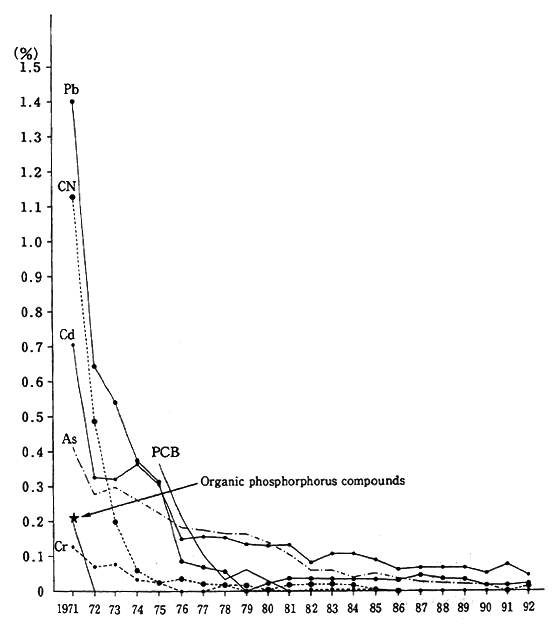
Source: Environment Agency
In Japan, heavy metals and toxic substances in water have been surveyed as items for human health and controlled by effluent standards for almost 30 years. Recently, various kinds of chemicals have been used in an extensive way. To decrease the environmental risk to water, the Environment Agency revised water quality standards for health in March 1993, added 15 items including organochlorine compounds and agricultural chemicals. Besides the revision, a new category called "items for monitoring," including 25 items, is set up for better water quality management (Table 4-2-1 and 4-2-2). Their levels today are not yet likely to cause health effects, but they will be monitored and discussed if they should be added to the items for EQS. New criteria for setting effluent standards were added to the Water Pollution Control Law in December 1993 in an effort to meet supplemental health criteria.
Table 4-2-1 Health Items in Environmental Quality Standards for Water
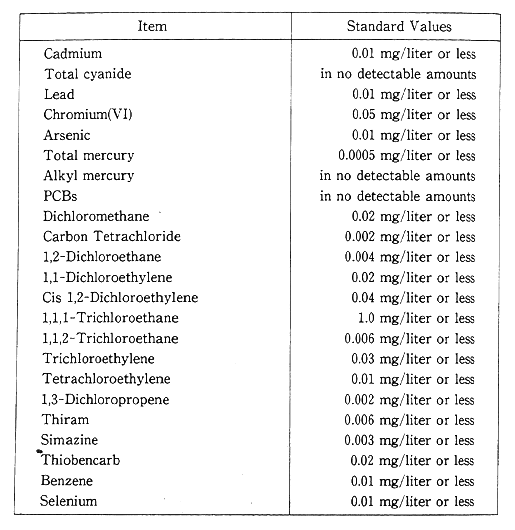
Standard values are the annual mean. However, the value for total CN is the maximum value.
Source : Environment Agency
Table 4-2-2 Categories Requiring Monitoring and Target Values
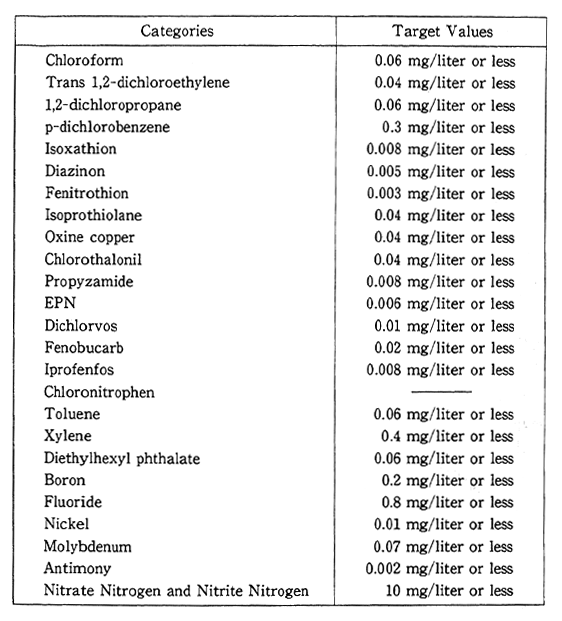
Source : Environment Agency
Moreover, efforts are being made to more effectively implement the Water Pollution Control Law, including previously listed categories.
In addition, necessary monitoring is being carried out, including ongoing studies of chemicals in the environment and of chemicals not yet subject to regulation under the Water Pollution Control Law.
The Environmental Agency is undertaking to ensure proper implementation of the Agricultural Chemicals Regulation Law to prevent pollution of the environment by agricultural chemicals. Based on the provisional guidelines aimed at preventing water pollution by agricultural chemicals used in golf course maintenance, proper usage of agricultural chemicals is to be instructed in collaboration with the local public body. It has been decided not to set registration standards of CNP, the pesticide used for rice fields, until acceptable daily intake has been set.
Fig. 4-2-2 Trends in Concentrations of Lead and Cadmium in the Major Rivers and Streams of Developed Countries
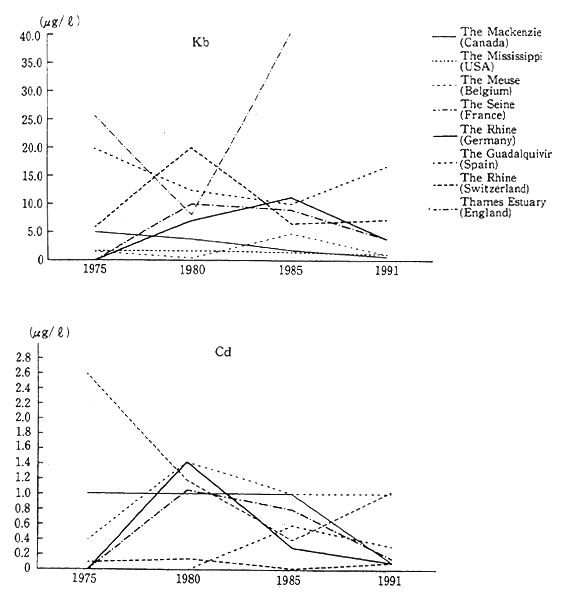
Source : OECD Environmental Data, 1993
Figure 4-2-2 shows trends in Pb and Cd pollution in major rivers in other countries. Rivers in many developed countries are showing a trend toward improvement; however, those in certain developing countries show severe pollution by toxic metals.
(2) Organic Pollutants
Japan sets environmental quality standards for water as part of the conditions for maintaining desirable living environments. Standards for rivers embrace five categories: biochemical oxygen demand (BOD), pH, suspended solids (SS), dissolved oxygen (DO), and number of colitis germ legions. Standards for lakes embrace seven categories: chemical oxygen demand (COD), pH, SS, DO, number of colitis germ legions, nitrogen, and phosphorus. Standards for marine areas embrace seven categories: COD, pH, DO, number of colitis germ legions, and normalhexane extracts (oils, etc.) as well as nitrogen and phosphorus, which were added in August 1993. Environmental quality standards pertaining to the various living environment categories reflect the conditions of each area, including the type of water usage and the extent of each.
As regards the attainment of environmental quality standards for conservation of the living environment, pollution by organic matter produces the greatest impact on the living environment around waters. With this in mind, BOD (rivers) or COD (lakes, reservoirs, and sea regions) which are closely tied in with organic pollution are assessed as representative items throughout the year, with the following findings. The rates for meeting environmental quality standards in the various living environment categories (BOD or COD) in fiscal 1992 were 75.2% overall (compared with 75.0% in fiscal 1991), 75.4% for rivers (75.4% in fiscal 1991), 44.6% for lakes (42.3% in fiscal 1991), and 80.9% for coastal waters (80.2% in fiscal 1991) (Figure 4-2-3). The rate for meeting environmental quality standards for total nitrogen and phosphorus in lakes was 39.6% (31.3% in fiscal 1991). Rivers show signs of a modest improvement in meeting the standards ; however, lakes continue to exhibit poor results. The rate for coastal waters is about 80%, which is relatively high compared to other water areas.
Water quality is difficult to maintain and improve in such enclosed and semienclosed bodies as lakes, reservoirs, inland seas, and bays because of the interruption of water exchange which causes accumulation of pollutants.
Progressive eutrophication in lakes generates problems, including strange smells in drinking water and reductions in water transparency and has negative effects on commercial fishing. A wide variety of living-, industry-, and agriculture-related sources of pollutants that alter COD may contaminate lakes and reservoirs.
Fig. 4-2-3 Trends in the Achievement Rate of Environmental Quality Standards (BOD or COD)
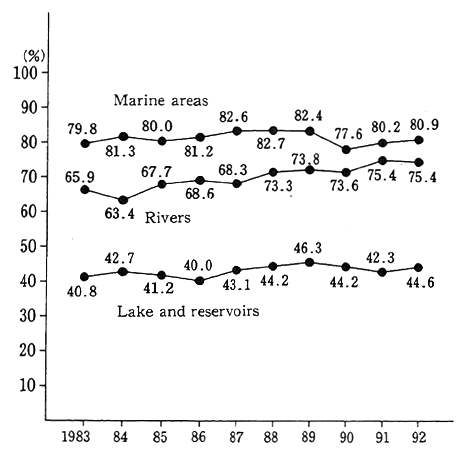
Source: Environment Agency
Proportions of pollutants in the water differ depending on how the catchment area is used and its industrial configuration if any. An examination of trends in COD in Lake Biwa, Lake Kasumigaura, and in Lake Teganuma, which had markedly poor water quality, shows some improvement while Lake Biwa remains largely unchanged.
In regard to semienclosed water areas, Areawide Pollutant Regulations on COD are being implemented in Tokyo Bay, Ise Bay, and the Seto Inland Sea, based on the Water Pollution Control Law and the Law Concerning Special Measures for Conservation of the Environment of the Seto Inland Sea. In these three marine bodies of water, the rate for meeting environmental quality standards for COD had remained largely unchanged in recent years in Ise Bay and the Seto Inland Sea/ Osaka Bay areas. Tokyo Bay, however, showed a marked improvement in fiscal 1992 compared with fiscal 1991 (Figure 4-2-4).
Fig. 4-2-4 Trends in Achievement Rates of Environmental Quality Standards for COD in Three Marine Areas
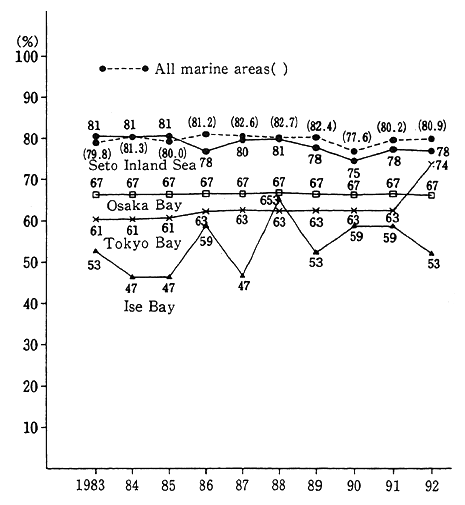
Source : Environment Agency
Fig. 4-2-5 Pollution of Rivers and Streams
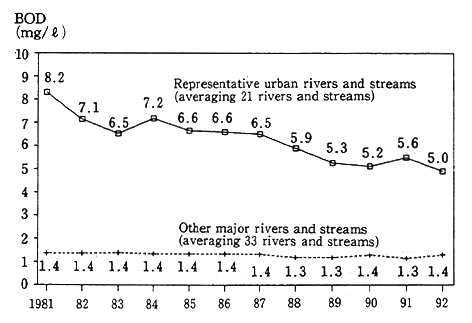
Source : Environment Agency
Although a certain portion of the urban rivers that had been very polluted has been showing a trend toward improvement in recent years, most remain very polluted (Figure 4-2-5).
This results from the increasing load of effluent into rivers and streams in the vicinity of large cities due to the growth of urban areas. A variety of initiatives are being undertaken to deal with the situation. These include the establishment of effluent processing facilities that use such techniques and equipment as joint processing and purification tanks to meet local sewerage and other requirements as well as the implementation of direct clean-up operations for rivers and streams. In Table 4-2-3, bodies of water are ranked according to a 1992 survey of BOD levels. An examination of the major causes of water pollution reveals that industrial effluent is the primary element in the case of the lower reaches of the Ibagawa River, which ranks first in pollution. Domestic waste is the primary cause in the cases of the Benten and Bizen rivers, which rank second and third, respectively.
Table 4-2-3 Rivers with High Levels of BOD
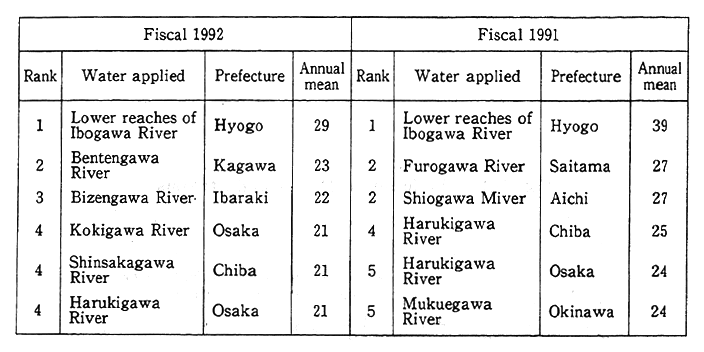
Source : Environment Agency
The Law Concerning Special Measures for Conservation of Lake Water Quality has the objectives of protecting the water quality of lakes and reservoirs and contributing to the preservation of the cultural traditions and health of the Japanese people. The law designated nine lakes and reservoirs as being critically in need of work to maintain environmental quality standards for water : Lake Kasumigaura, Lake Inbanuma marsh, Lake Teganuma, Lake Biwa, Lake Kojima, Lake Suwa, Kamafusa Dam Reservoir, Lake Nakaumi, and Lake Shinji. Programs are also being formulated under the law to protect the water quality of lakes and reservoirs.
Moreover, in addition to regulations introduced under the Water Pollution Control Law, special provisions are being formulated under the law to exert tight control over sources of water pollution.
Pollutants tend to easily accumulate in enclosed bodies of water. Throughout Japan such bodies have high concentrations of nitrogen (N) and phosphorous (P) due to runoff. The surge in growth of algae and other water organisms in the presence of these chemicals leads to progressive eutrophication, which worsens water quality.
This is the cause of "red tides," which damage the fishing industry, create offensive odors, make swimming in sea water unpleasant, and pollute beaches. In addition, the increase in organic substances may cause a rise in COD levels, making it difficult to attain environmental quality standards, and may lead to a lowering in the levels of DO, which causes "blue tides." In August 1993, the Environment Agency established effluent standards for N and P and, from October 1993, implemented effluent controls on 88 enclosed water areas nationwide. In addition, the Environment Agency is promoting countermeasures against pollution by organic substances and subsequent eutrophication in accordance with environmental quality standards for N and P in Tokyo Bay, Ise Bay, and Osaka Bay.
In recent years, humic acid and organic substances which are nontoxic have been produced in public water areas as a result of chlorine introduced to the water during purification. The Japanese people have become increasingly worried about trihalomethane, a suspected carcinogen, in drinking water and are demanding special countermeasures to ensure the water quality of public water areas that serve as sources of drinking water.
For this reason, Japan is formulating a comprehensive program, including controls and initiatives, to protect the quality of public sources of drinking water under the Law Relating to Special Provisions to Protect the Quality in Water Bodies that Are Drinking Water Sources in order to Prevent Damage to Designated Water Uses. Moreover, local administrative bodies are undertaking initiatives to 'protect the quality of drinking water sources based on the River Management Program under the Law on the Promotion of Total Initiatives to Protect Drinking Water Sources.
In Figure 4-2-6, data is provided on the water quality of major rivers and lakes in the industrialized countries in terms of BOD levels, P, and N, revealing an overall trend toward improvement, although the conditions of a few rivers and lakes are either leveled off or deteriorating.
Fig. 4-2-6 Water Quality (BOD) of Major Rivers in Developed Countries Source: OECD Environmental Data
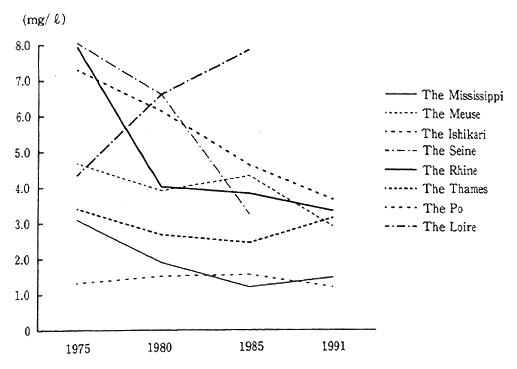
Fig. 4-2-6 Water Quality (Total Nitrogen) of Major Lakes and Reservoirs in Developed Countries
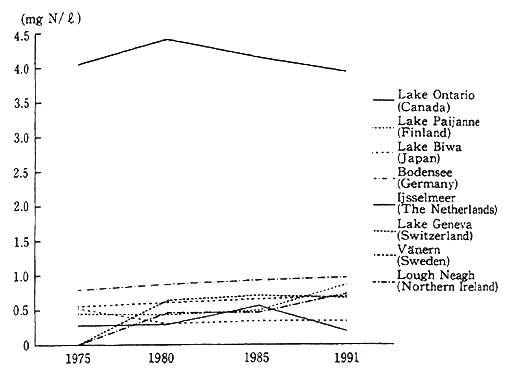
Source: OECD Environmental Date 1993
Fig. 4-2-6 Water Quality (Total Phosphorous) of Major Lakes and Reservoirs in Developed Countries
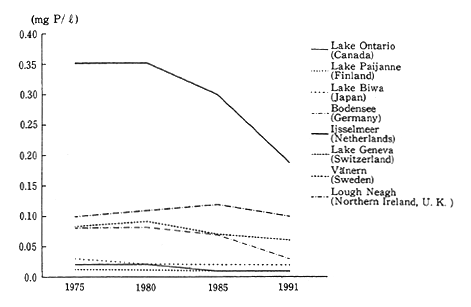
Source:OECD Environmental Data
(3) The Oceans
The oceans are, in most cases, the ultimate destinations of accumulations of pollutants. Although the oceans are vast, it is now recognized worldwide that the oceans are becoming polluted because of human activities.
The number of cases in which marine pollution was confirmed by the Maritime Safety Agency in 1993 was 762, about a 10% decline from the 846 cases in the previous year. This figure was the smallest since the taking of statistics began in 1971 (Figure 4-2-7). Of the 1993 total, oil pollution was 445 cases, which accounted for 60% of the total cases. Cases where pollution was caused by wastes, toxic chemicals, and factory effluent numbered 277, and 40 cases of red tide were found as well. About 80% of the cases of oil pollution were attributable to shipping vessels; of these, most were attributable to carelessness, followed by intentional discharges of oil and shipwrecks. In contrast to the decline in the number of shipwrecks, the incidence of intentional dis-charges is increasing. Waste is the predominate cause of pollution among non-oil pollution, and most cases are caused intentionally.
Fig. 4-2-7 Trend in Numbers of Confirmed Cases of Marine Pollution
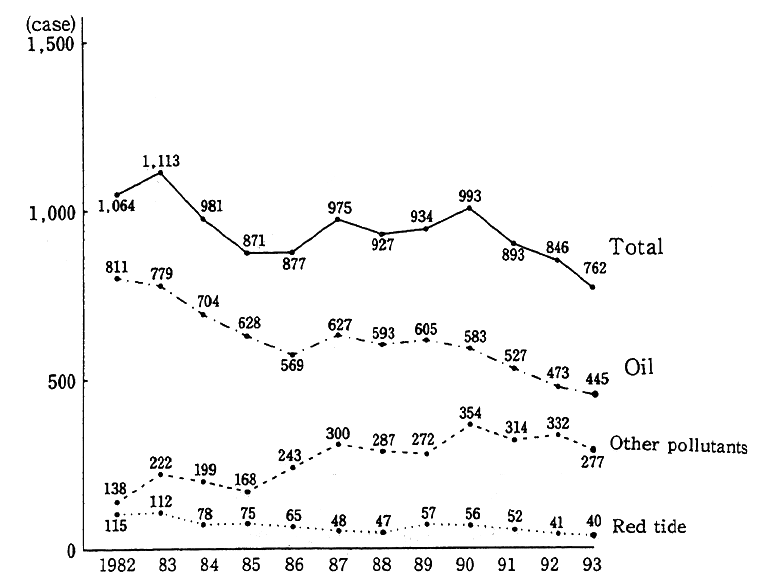
Source: Environment Agency
In fiscal 1992, the Environment Agency undertook a survey of the pollution in Japanese coastal waters. This survey covered 29 observation points, including those south of Osaka Bay, south of Okinawa, north of Shimonoseki, and around other bays. The survey measured levels of Hg, Cd, Pb, and other heavy metals as well as PCBs. All substances were found at levels unchanged from the past. Moreover, observations of background marine pollution carried out by the Meteorological Agency in waters near Japan and in the northwest Pacific have found the levels unchanged year after year.
The Maritime Safety Agency analyzed oil in seawater and sea bottom sediments, PCBs, heavy metals, and other pollutants in a study of marine pollution in Japan's offshore waters in fiscal 1992. Although the survey does show a small fluctuation in the long term, the overall results indicate levels are remaining constant or declining.
A survey of drifting waste and debris was undertaken in a study of marine pollution in coastal waters. This visual survey compared the area within 50 nautical miles from the coast with that beyond 50 nautical miles. More waste was found in coastal areas, especially in the Seto Inland Sea. This consisted of pieces of styrofoam and other petrochemical products less than 50cm in size (Figure 4-2-8).
Fig. 4-2-8 Sightings and Composition of Drifting Debris
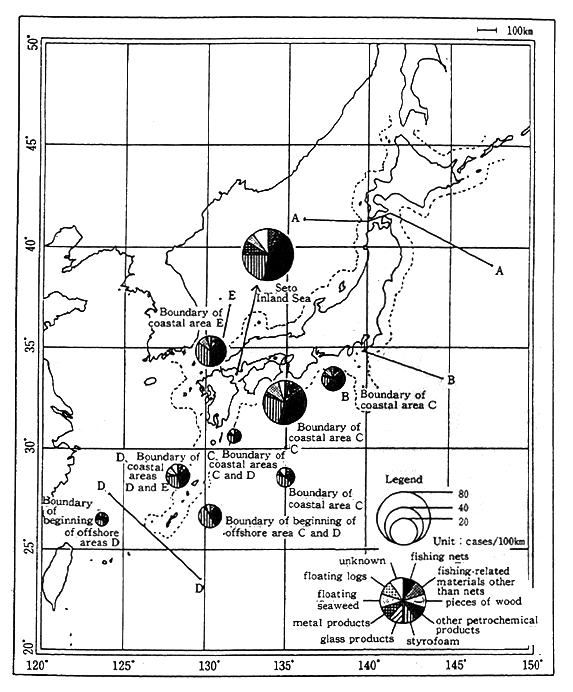
Source: Environment Agency
A survey of small drifting objects found that most were less than 10mm in size at any observation point and most of them were plant and petrochemical products.
Waste materials drifting in the sea have several negative effects. Sea birds, marine animals, and other sea creatures may be injured by mistaking drifting waste materials such as resin pellets (small pellets used as the raw material for plastic products) and other plastics for food and ingesting them. Animals may die by becoming entangled in drifting nets, ropes, and plastic materials. A visual survey of floating marine debris carried out by the Fisheries Agency from fiscal 1987 through fiscal 1991 found a high distribution of plastic materials concentrated largely along the coast of Japan and the eastern portion of the Pacific Ocean, from north latitude 25 degree to north latitude 40 degree (Figure 4-2-9).
Fig. 4-2-9 Drifting Objects in the North Pacific All plastics (1987-1991)
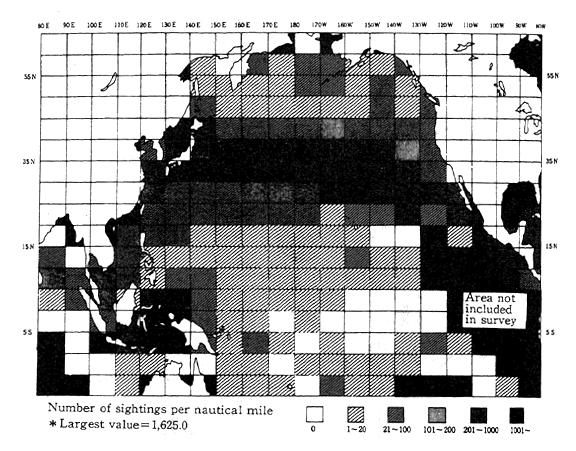
Source : Fisheries Agency
Of the materials sighted in this survey, 25.4% were styrofoam, 22. 1% were other plastics, 20.3% were drifting seaweed, 11.8% fishingrelated materials (other than fishing nets), 6.2% were pieces of wood, 5. 4 % were drifting logs, and 2.2% were glass materials.
In the study of background marine pollution carried out by the Meteorological Agency drifting tar balls (clumps of oil) were observed offshore. There is concern that the discharges of crude oil from vessels --done intentionally, through carelessness, or released as a result of shipwrecks-could bring about large-scale damage to nature. Accidents involving tankers continue: the grounding of the tanker Exxon Valdez in Alaska's Prudhoe Bay in March 1989 leaked about 40,000 kiloliters of crude oil, which resulted in severe damage including the deaths of about 30,000 seabirds and the loss of the sardine fishery industry. This was followed by incidents involving the tanker Maarsk Navigator off Sumatra, Indonesia, in January 1993 and the tanker Seki in Oman Bay in March 1994.
Crude oil released in this manner decomposes very slowly. Because such releases have highly destructive effects on ecological systems, the International Maritime Organization (IMO) and other organizations are taking an international approach to prevent marine pollution through such measures as the double hulling of tankers. In keeping with the partial revisions of the appendix to the Marine Pollution Treaty of 1973/1978 (Marpol), which was intended to prevent marine pollution from discharges of oil, toxic liquids, and other substances from vessels, and to the appendix to the Convention on the Prevention of Marine Pollution by Dumping of Wastes and Other Matter (London Dumping Convention), Japan carried out revisions to related legislation including the issuance of a directive on the Law Relating to the Prevention of Marine Pollution and Maritime Disaster. These changes included an increase in the number of toxic liquids covered, a prohibition of the discharge of toxic liquids into Antarctic waters, a prohibition of the incineration at sea of industrial wastes, and a tightening of controls on the disposal of wastes, including beryllium, at sea.
The government of the Russian Federation issued a white paper in April 1993 in which it stated that it had for many years dumped radioactive wastes in waters near Japan. Moreover, Russia dumped liquid radioactive waste in the Japan Sea in October 1993.
Under a decision by the Executive Committee of the Japanese government's Headquarters for Measures against Radiation (headed by the director general of the Science and Technology Agency), an emergency study of radioactivity in the Japan Sea was carried out in the spring and autumn of 1993.
Based on the results of this study, the Executive Committee of the Headquarters for Measures against Radiation stated that "the studies so far have not detected abnormal amounts of radioactivity and there is no danger of negative effects on people's health due to the marine dumping concerned."
(4) River, Lake, and Ocean Sediments
The sediments at the bottom of rivers, lakes, and the ocean are believed to hold accumulations of pollutants that have come by a variety of routes. It is known that sludge in Japan has become markedly polluted with mercury and other pollutants as a result of industrial activities, and dredging of bottom sediments totaling 28,130,000m3 is being carried out nationwide.
A study of sediments was carried out in fiscal 1992 to determine chemical residues in the general environment and to ascertain levels of concentrations of these substances. Although the study detected in sediments 9 substances among the 15 covered in the study, none of the concentrations detected posed any direct problems. A total of 20 substances has been detected as the result of ongoing monitoring of sediments.
The Environment Agency has been carrying out follow-up studies since fiscal 1985 on the state of pollution by toxic chemicals due to the emergence of the issue of environmental pollution by chemicals such as dioxins that may be produced unintentionally as part of the process of chemical compounding or combustion. According to the results of the study of fiscal 1992, pollution of the general environment by dioxins does not, at the present, pose any danger to human health. Nonetheless, small concentrations of diox ins have been detected, and it is necessary to continue monitoring (Table 4-2-4).
(5) Groundwater
Groundwater is a precious resource; it is of high quality and its temperature remains largely constant. At present, about 30% of urban water needs are met with groundwater. From around the 1980s, trichloroethylene and other pollutants showed up in large concentrations in groundwater, and studies indicate widespread pollution of groundwater. For example, pollution by trichloroethylene, at values exceeding the standard (0.03 mg/liter) for groundwater, was discovered in Kimitsu City, in Chiba Prefecture.
Table 4-2-4 Survey of Sediments for Dioxins
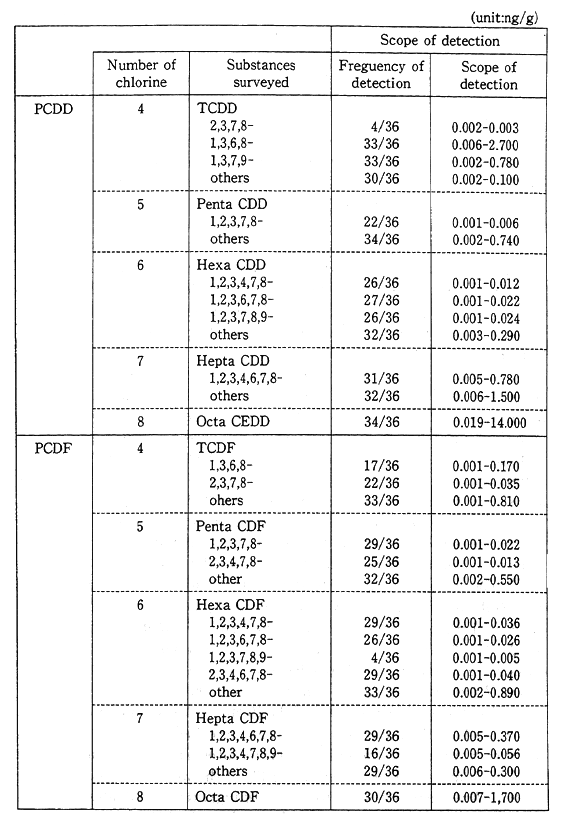
Source : Environment Agency
The well in question is used for purposes other than drinking. The contaminated area is quite large, amounting to about 53ha. The pollution of groundwater can to some extent spread throughout the vicinity. Moreover, it is difficult to clean up groundwater once it has been polluted. For these reasons, the countermeasures being formulated to cover wells that have been found with excessively high concentrations also include wells used for drinking water.
Under the revision of the Water Pollution Control Law that was implemented in June 1994, controls were instituted on the permeating of effluent containing toxic substances to the earth, and national and local governmental bodies are undertaking constant monitoring of groundwater quality. A general survey was undertaken in fiscal 1992 to ascertain overall groundwater quality in all regions. Of the wells surveyed that exceeded standards, the proportions were 0.4% and 0.7% for trichloroethylene and tetrachloroethylene, respectively; 0.1% for cadmium ; 0.2% for arsenic ; 0.1% for total mercury ; and 0.1% for 1,1, 1-trichloroethane. No wells were found to exceed standards for cyanogen compounds or PCBs.
Although since 1989 modest declines have appeared in trichloroethylene and tetrachloroethylene levels, these substances are still found in many locations. As a result, once a general survey discovers pollution, periodic monitoring consisting of districtwide surveys is undertaken near the polluted wells to ascertain the extent of the pollution. A high proportion of wells have been shown to exceed standards. The figures for trichloroethylene are 3.5% in district surveys of the vicinity of polluted wells and 9.0% in periodic monitoring studies. For tetrachloroethylene, the figures are 6.3% in district surveys of the vicinity of polluted wells and 19.7% in periodic monitoring studies.
The problem of groundwater contamination by nitrate has been noticeable in Europe and North America since the 1960s due to the overuse of nitrogen-based fertilizers in farming. Nitrite, which is easily reconstituted from nitrate, can cause methemoglobinemia, so-called cyanosis. For this reason, Japan has set a standard of 10 mg/liter, based on the Water Works Law, for nitrate and nitrite.
As indicated in Section 2 of the Preface, cases of polluted groundwater used as drinking water sources have been found in Japan. In addition, a survey carried out in 11 prefectures and other administrative units of groundwater indicated that 5.4% of the wells surveyed exceeded the guideline items for monitoring of 10 mg/liter for nitrates, which is the value above which monitoring is required. Japan therefore needs to undertake further research on the state of pollution of groundwater by nitrate.
(6) The Environmental Amenities around Water
Rivers, streams, and coastal areas play important roles in our daily life and socioeconomic activities. Artificial changes such as land reclamation related to advancing urbanization are resulting in the gradual loss of pleasant waterside environments, damaging organisms that live near water as well as drying up natural springs, and reducing the flows of rivers and streams. At the same time, concern about waterside areas is growing, leading to increasing demands for pleasant waterside environments.
It is common for natural springs within cities to decline in volume or dry up, leading to reductions in the flow of the small and mediumsized rivers and springs that they feed. A 1992 report of the state of underground water in metropolitan Tokyo found that more than 180 natural springs within downtown Tokyo had either dried up or disappeared during the period from the beginning of Meiji (1866) to 1990 and the normal volume and flow in small and medium-sized rivers, streams, and water channels in built-up areas had diminished or in some cases disappeared entirely except when rain fell (Figure 4-2-10). Rivers, streams, and water channels are passageways which connect areas of greenery where various kinds of animals breed and live, therefore a continuous waterside environment is inevitable. In addition, initiatives are emerging to protect waterways by reviving and cleaning up watercourses because one essential countermeasure to clean up waterways that have difficulty in attaining environmental quality standards is to maintain the volume of flows in rivers and streams.
Demands to reclaim land from the sea in public coastal waters continue to be strong because public land is scarce and it is difficult to find space for the final disposal of industrial wastes on land. A variety of development projects are currently planned for the coastal waters of Tokyo Bay, raising fears that these will have negative effects on water-related resources, including the loss of the natural cleansing capability of waterside environments, chances that let people approach water, and the productiveness of fisheries (Table 4-2-5).
Table 4-2-5 Comparison of Tokyo Bay with Representative American Bays
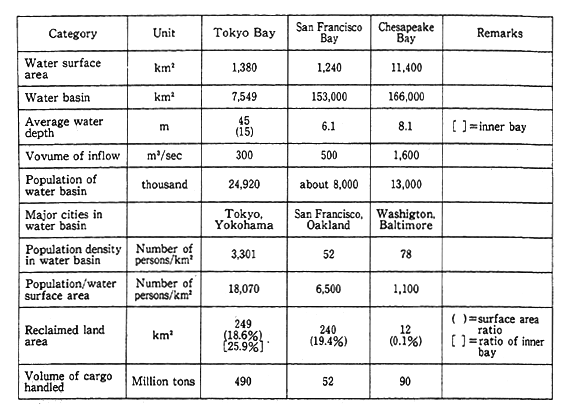
Source : Environment Agency
To prevent eutrophication in Tokyo Bay, Ise Bay, and Osaka Bay, the Environment Agency is working to set environmental quality standards for total nitrogen and total phosphorus and to specify water areas. These water areas are keyed to natural characteristics and take into account the natural purifying roles that tidelands, shallows, sand beaches, greenery, and other natural features are thought to play. For example, the reeds that grow in clumps in ponds, along rivers, and in wetlands nationwide absorb inorganic salts from the water and soil, and studies are now focusing on the purification process carried out by the various microorganisms in the root area of the rushes. It appears that fields consisting of these reeds are an environment intimately linked to both the local hydrosphere and soil and as such possess special ecosystems.
Waterside areas that are clean and unpolluted offer pleasant environments, spiritually satisfying places where fish can live and people can play and enjoy rewarding recreation. The Environment Agency, along with the Ministry of Construction and other bodies, has since 1974 carried out surveys of aquatic organisms in rivers and streams nationwide. In addition, these surveys are carried out with the participation of ordinary citizens who, by studying mayflies, river crabs, and other common natural aquatic organisms, gain insights into the water quality of water areas.
Moreover, waterside areas have always provided unique scenery, and people now are demanding that revetments and spatial arrangements along rivers and streams are harmonized with the environs to be highly water friendly and pleasant. For example, Yamaguchi City succeeded in creating an environment attractive to fireflies alongside its Ichinosaka River by using natural rocks in revetments and regrowing natural waterside vegetation. Similarly, Yokohama used natural water to create enjoyable rivulets that flow even with small water volumes. Local government bodies are undertaking measures to protect such waterside environments. For example, metropolitan Tokyo is formulating a waterside environment protection program to maintain and create enjoyable waterside environments. Similarly, the city of Sendai, in Miyagi Prefecture, is protecting the waterside environment of the Hirose River to create a pleasant environment.
4-3 Soil as an Environment
(1) The State of the Soil Environment
The soil, generated with the significant involvement of organisms' activities, constitutes an important component of the environment and plays an important role in the maintenance of ecosystems. If soils are degenerated and the functions of soils are impaired, the existence of man and other organisms will be threatened and nature's ecosystems will be aggravated.
Soil pollution is one type of soil degradation. Soil is polluted directly by pollutants seeping from raw materials or from the reclamation of wastes, and also polluted indirectly by water pollution and air pollution. Soil pollution is a cumulative pollution with long-lasting negative effects on agricultural products and groundwater.
With soils of agricultural land polluted, the growth of crops is hampered and polluted crops impair man's health in some cases.
Soil pollution is one of the longest examples in history. With farmland pollution along the Watarase River in the Meiji Era and also farmland pollution by cadmium and other chemicals in the basin of the Jintsu River in the postwar years, significant problems have been posed regarding the protection of the health of the population.
For this reason, measures have been taken to detect and improve the sources of pollution under the Water Pollution Prevention Law and other legislation. As for agricultural land, standards were set for cadmium, copper, and arsenic under the Agricultural Land Soil Pollution Prevention Law. Agricultural lands which are polluted beyond the standard are to be dealt with by soil replacement and other projects.
A detailed survey of soil pollution in agricultural land was undertaken in fiscal 1992. There have been no new districts since 1986 where soil pollution in excess of the standard values have been detected. The total area of places where topsoil replacement and other projects were to be completed by the end of fiscal 1993 was 4,720 hectares, and the progress rate for places which are polluted beyond standard values (7,140 hectares) was 66.1% (65.2% in fiscal 1992).
Table 4-3-1 Number of Cases of Urban Pollution Broken Down by Industrial Category and Type of Pollutant
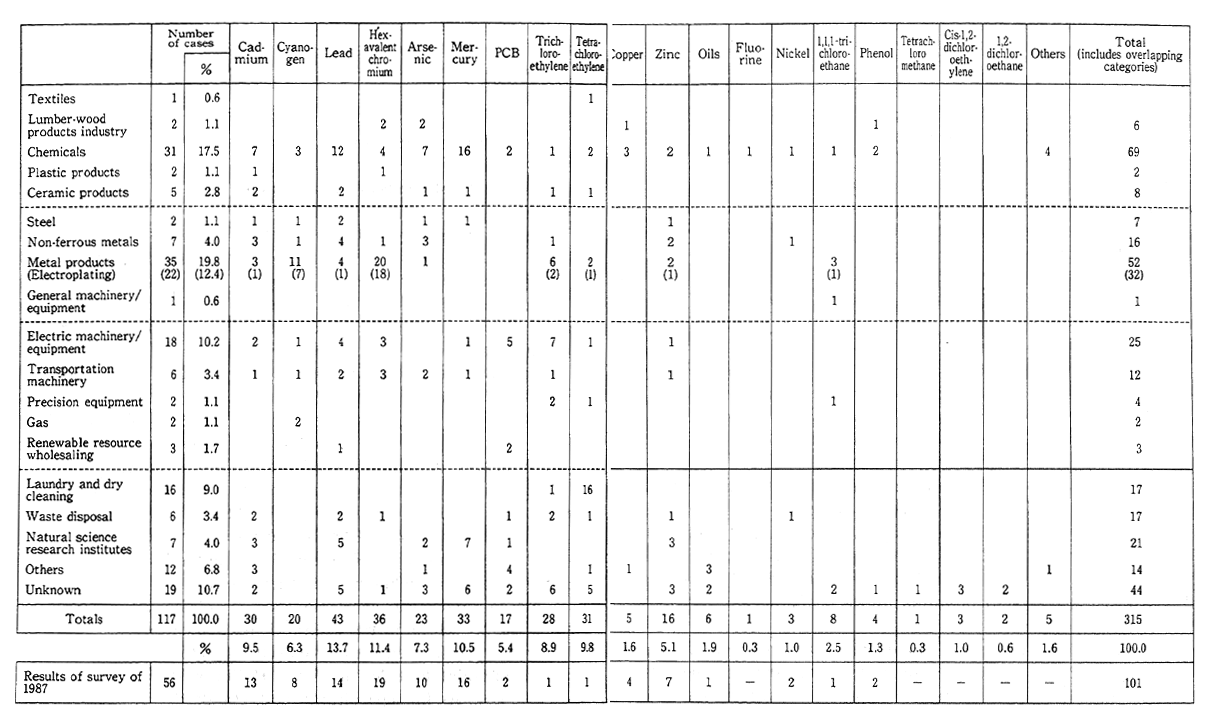
Source : Environment Agency
As for urban land except agricultural land soil, the number of cases in which soil pollution has been revealed is increasing nationwide. Quite a few cases of soil pollution are discovered when former factory sites are redeveloped. A 1992 study of soil pollution countermeasures ascertained a total of 177 such cases of urban soil pollution since fiscal 1975, and the number of such cases identified has been increasing in recent years (Table 4-3-1). Of these 177 cases, it was confirmed in 75 that
the soil pollution had negative effects on the neighboring environment as well as on the soil. In 62 cases, groundwater was polluted by trichloroethylene and tetra-chloroethylene, among others.
The causes of soil pollution consist mostly of leaks due to damage to production and other facilities, the inappropriate burying of wastes in the compounds of factories before the enactment of the Waste Disposal and Public Cleansing Law, the improper handling of pollution-causing substances, and illegal dumping caused by the difficulty in securing sites for the final disposal of wastes, among others. By industrial category, the most common sources of soil pollution are chemical production, electroplating, and electric machinery and appliance production. The list of most common pollutants includes heavy metals such as lead, hexavalent chromium, and mercury, and recently there has been a marked increase in trichloroethylene and tetra-chloroethylene. Given this situation, in February 1994, the list of substances covered by environmental quality standards related to soil pollution, which included cadmium and arsenic, was revised by adding 15 substances, including trichloroethyl ene, tetra-chlo roethylene, and tetrachloro methane, to raise the total to 25 substances. This step was taken as part of an effort to deal appropriately with soil pollution due to toxic substances and to promote measures intended to protect human health (Table 4-3-2).
When it comes to the conditions of foreign countries, problems are posed in the United States about pollution at sites where final waste disposal plants used to be in the years when lax controls were in force, and soil pollution by organic solvents and other agents leaked from factories.
The companies that bear responsibility as polluters have been ordered to take measures on joint responsibility. Under the Super Fund Act, designed to enforce measures through a fund contributed to from taxation on oil and chemical products, and other legislation, measures are taken for purification.
In Germany, the Netherlands, and other European countries, positive soil pollution prevention measures are in force. As for Eastern Europe, it was detected in Bulgaria that plots with an area of 300m2 adjacent to a metal plant are polluted by heavy metals. In Olkusz and Slavkov, Poland, the world's highest values of lead and cadmium were detected in the soil, and pollution by the inappropriate treatment of wastes from industrial belts is an issue.
In developing countries, soil atrophy is a significant issue, as it is caused by excessive pasturage, forest depletion, and improper agricultural practices. In a global perspective, problems posed by soils, such as its washout and chlorination by the upstream movement of brine, are generating calls for international cooperation.
Table 4-3-2 Environmental Quality Standards for Soil Pollution
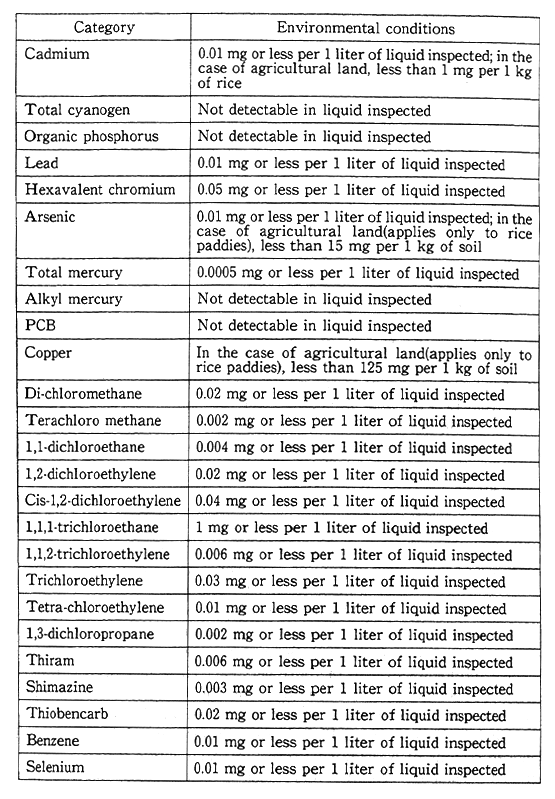
Source: Environment Agency
(2) The State of Ground Subsidence
Ground subsidence is usually caused by the lowering of the underground water table due to overpumping, which causes the clay layer of the subsoil to shrink. Ground that has subsided can result in irreparable damage to buildings and flood damage.
Underground water is a source of high-quality water at a constant temperature. It is inexpensive and widely used for drinking, industrial, and agricultural purposes and to melt snow in winter. The massive increase in demand for water to match improvements in living standards and industrial progress, along with the large-volume pumping of deeper and deeper strata of underground water due to the advancement of well-digging technology, is resulting in considerable ground subsidence.
Prior to the war, ground subsidence was long evident in Tokyo' s Edo Ward and in the western part of Osaka. Although this process stopped temporarily due to the stagnation of the economy following the war, from 1965 the appearance of severe ground subsidence exceeding 20cm annually throughout the nation has been observed. Subsequently, controls on pumping of groundwater were imposed. Although this step tended to slow or halt ground subsidence, it still remains very evident in some areas.
Land areas subject to ground subsidence of 2cm or more per year increased in fiscal 1992 to 19 areas with a total surface area of 525km~, from 17 areas with a total surface area of 4 67km year before. Areas with severe subsidence of 4cm or more per year increased from 4 with a total surface area of 6km fiscal 1991 to 6 with a total surface are~ of 25km fiscal 1992. The most severe case of ground subsidence ir fiscal 1992 was in Minami Uonuma, in Niigata Prefecture, where subsi.~ dence of 5.7cm was registered. Several areas were confirmed to hay, ground subsidence of 4cm or more per year. These included the Kant ;~ Plain in Tochigi Prefecture with 5.3cm, the Kanto Plain in Ibarak~ Prefecture with 4.8cm, the Kanto Plain in Saitama Prefecture with 7cm, and the Cikugo-Saga Plain in Saga Prefecture and the central an Shonan regions of Kanagawa Prefecture, each with 4.3cm. By region ground subsidence remains very much in evidence, especially in th northern part of the Kanto Plain as well as in the Kyujukuri Plain an the Chikugo-Saga Plain.
Fig. 4-3-1 Ground Subsidence Nationwide in Fiscal 1992
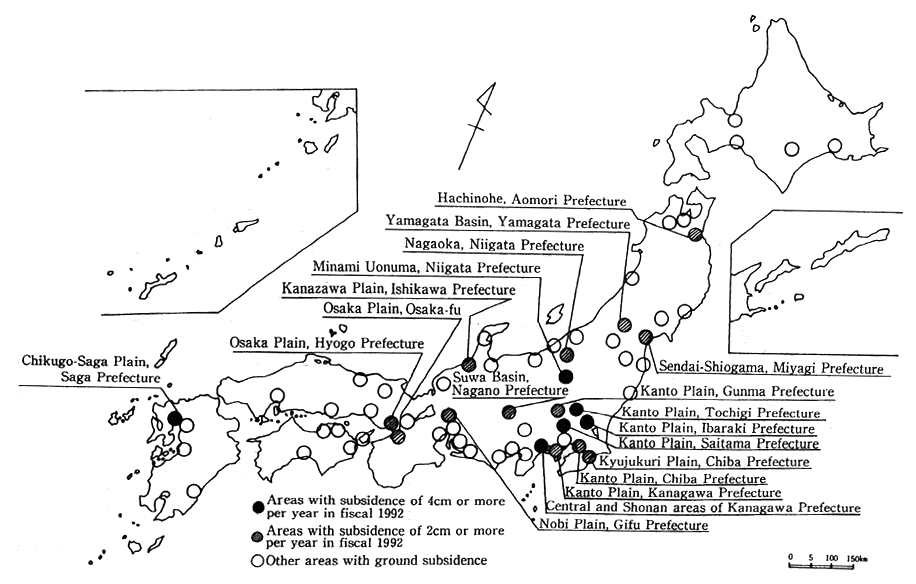
Reference : Survey by Environment Agency
4-4 The Waste Situation
(1) General Wastes
Garbage produced by people in the course of their daily lives refers to general waste (waste other than industrial waste) excluding human waste and is classified into household-related garbage and business-related garbage. The types of garbage are increasing in step with the diversification of lifestyles, and large household items that are difficult to dispose of properly are posing problems. The volume of garbage produced in fiscal 1991 amounted to 50,770,000 tons (about 136 times the amount that would fill the Tokyo Dome), a fiscal year-on-year increase of 0.6% over the 50,440,000 tons in fiscal 1990, which itself was an increase of 0.9% over the previous fiscal year. The volume of garbage produced in fiscal 1991 was 1,118 grams per capita (as against 1,120 grams per capita in fiscal 1990), the first decrease in eight years. A comparison of past trends shows that the volume of garbage produced has increased in step with the rising pace of people's lives and social activities after World War II. Although the volume of garbage de-creased temporarily at the time of the oil crisis in 1973, it has subsequently kept increasing (Figure 4-4-1).
Fig. 4-4-1 Trends in Total Garbage Produced and Amount Per Capita Per Day
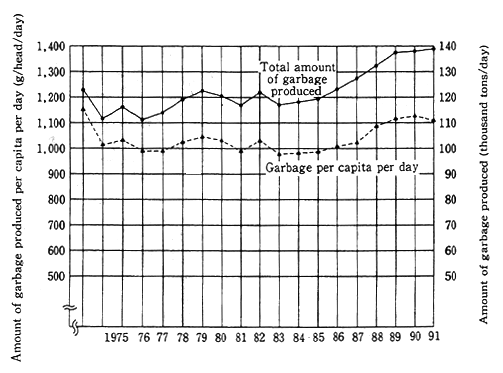
Source : Ministry of Health and Welfare
As for general waste, it is difficult to secure disposal sites, particularly sites for final disposal. For this reason, the excess capacity of final disposal sites is rapidly declining in step with the increase in the amount of garbage produced. In fiscal 1991, Japan had 2,250 sites for final disposal (groundfills), compared with 2,336 sites in fiscal 1990. Available disposal capacity in fiscal 1992 amounted to 156.83 million cubic meters, about the same as in fiscal 1990 (156.7 million cubic meters). The remaining capacity of these sites expressed in years averages about 7.8 nationwide, if the specific gravity of the garbage is calculated at 0.82. Metropolitan Tokyo, along with surrounding areas in Kanagawa Prefecture, Chiba Prefecture, and Saitama Prefecture, accounted in fiscal 1991 for 24.4% (about 4 million tons) of the total garbage produced in Japan. However, the remaining capacity (expressed in terms of years) of this area's final disposal sites was only about 4.9, lower than the national average. It is becoming difficult to secure such processing sites, imparting great urgency to issues such as reducing the amount of garbage produced, recycling, and reuse. The Waste Disposal and Public Cleansing Law was revised in fiscal 1991, and the Law to Promote Reuse of Renewable Resources was enacted, all of which had the effect of promoting the use of recyclable resources.
It is estimated that over the 12 months of 1992, Japan emptied about 31.7 billion beverage cans, which represents a 2.6% increase over the approximately 30.9 billion cans emptied in the previous year (1991).
The Environment Agency has been carrying out surveys continuously since fiscal 1983 to determine the facts regarding the littering of empty cans throughout Japan. Such littering was about the same in 1992 as in 1993 along hiking and mountain climbing trails and in parks and public places. Other places, however, showed marked year-on-year increases, and the situation has been deteriorating over the past five years. By category, national and other main roads remained ranked first at 2.6 units; this was followed by seashores and lake shores as well as ordinary roads, all of which showed a year-on-year increase of about 50% (Table 4-4-1). National and local administrative bodies are undertaking a variety of approaches against the littering of empty cans; nonetheless, stepped-up action is required, such as more recycling, as a fundamental resolution of the problem has not been achieved yet.
Concern about preventing pollution of water for public use caused by the effluent from untreated sewage treatment plants has been rising in recent years. The volume of human waste treated (total volume of waste from non-flush toilets) in fiscal 1991 was about 36.76 million kiloliters, about the same as the amount in fiscal 1990 (about 36.21 million kiloliters). The percentage of the population not connected to sewage lines is 32% (39.69 million people), which remains a relatively large proportion of Japan's total population.
There are as yet no generally accepted standard evaluation methods regarding the amount of general waste produced by the members of the OECD ; however, the amount has been increasing on the whole in virtually every country since 1975 (Table 4-4-2).
Table 4-4-1 Number of Empty Cans Found as Litter (units per day: 100 meters for roads, etc.; 1,000 square meters for parks, etc.)
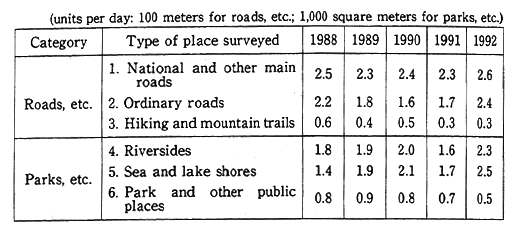
Source : Environment Agency
Table 4-4-2 Trends in the Amount of General Waste Produced in the Industrialized Countries
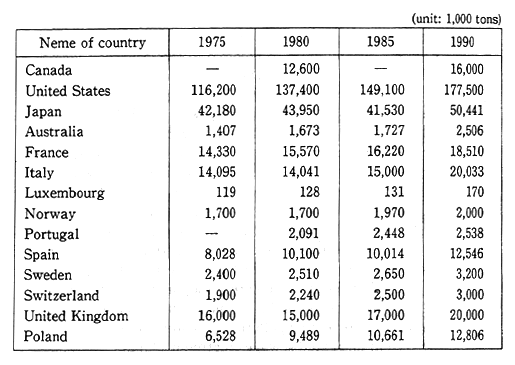
Source: OECD Environmental Da 1993
(2) Industrial Wastes
The total volume of industrial waste produced in fiscal 1990 was 397.74 million tons, about 7.8 times as much as the amount of household garbage produced in fiscal 1991. A comparison of that figure with the amount produced in fiscal 1985, in order to examine the growth of the total amount of industrial waste, shows an increase of 26.4%, which is more or less the same as the increase in the GNP over the same period. This suggests that the amount of industrial waste grows in step with the growth of the economy (Figure 4-4-2).
Fig. 4-4-2 Trends in Amounts of Industrial Wastes Produced in Japan
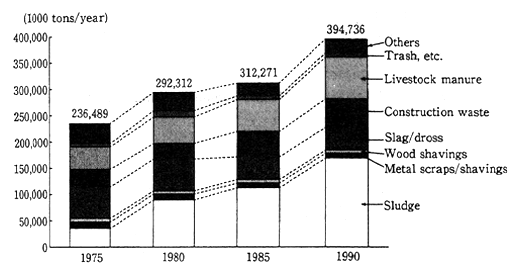
Source: Environment Agency
Of the total amount of industrial waste, about 150.57 million tons are reused, leaving the amount of final disposal to be about 89.73 million tons. A breakdown of the contents of industrial waste reveals that 43% is sludge, 20% is livestock manure, and 14% is construction waste. According to surveys of industrial waste carried out by the Ministry of Health and Welfare every five years, sludge has been increasing greatly since fiscal 1975 while waste acids and alkalis have been decreasing.
Volume of industrial waste proportionately by industrial category shows agriculture ranking first, accounting for 20% of the total, followed by the construction industry; the electricity, gas, heat, and water supply industries; and the steel industry.
A variety of controls on the treatment and disposal of industrial wastes have been imposed under the Waste Disposal and Public Cleansing Law in order to ensure proper treatment and disposal. Of the total industrial wastes produced (excluding the amount reduced through intermediate treatment and the amount reused), 23%, or 89.73 million tons, is disposed of in landfills.
Recently, the securing of final treatment sites (landfills) has become a great problem. The remaining capacity of final treatment sites for industrial wastes was down to only 14,230,000 cubic meters in the metropolitan Tokyo region (Ibaraki, Tochigi, Gunma, Saitama, Chiba, Tokyo, and Kanagawa prefectures), although much of the region s industrial wastes are treated in other prefectures. The increasing difficulty in securing final treatment sites is one of the factors behind the illegal dumping of industrial wastes, giving rise to concerns of increased soil pollution. The illegal dumping of industrial wastes in fiscal 1993 rose to about 1.45 million tons (compared with 1.37 million tons in fiscal 1992), centered largely on construction wastes produced in connection with construction projects (Figure 4-4-3).
Fig. 4-4-3 Trends in the Illegal Dumping of Industrial Wastes
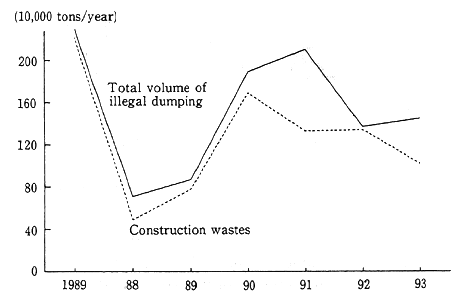
Source: National Police Agency
There is no uniform data available regarding the amount of industrial wastes produced by OECD members because the definition of industrial wastes differs from country to country. For this reason, it is difficult to make a comparison between the various countries. However, it is estimated that the OECD as a whole produced about 1 billion tons of industrial wastes annually in the first half of the 1980s, about 1.3 billion tons annually in the second half of the 1980s, and about 1.5 billion tons in 1990.
(3) Transboundary Movements of Hazardous Wastes
As the volume of waste generated by human activities increases and its characteristics change against the backdrop of expanding economic activities and ongoing internationalization, there is an increase in the number of instances in which such wastes are sent across borders in a search for disposal sites due to the increasing difficulty of finding disposal sites in the country where the wastes were produced. Hazardous wastes in particular tend to move from countries where treatment is expensive to countries where treatment is cheaper or from countries where treatment is tightly controlled to countries with less restrictive controls. There is concern that the improper treatment of such hazardous wastes in the host country could have negative impacts on that country's living environment and its natural ecosystems. As a result, the global movement of hazardous wastes has become an international problem.
One example of the transboundary movement of hazardous wastes is the case of the soil polluted with dioxin in Seveso, Italy, in 1976. The location of this polluted soil was unknown, until it was discovered in 1982 in France. Other cases include a Norwegian company transporting 15,000 tons of hazardous wastes from the United States to Guinea, where it was dumped; 3,900 tons of hazardous wastes transported from Italy to Nigeria under the label of "chemical products," where they were dumped; and a vessel laden with 14,000 tons of toxic incineration ash from Philadelphia, in the United States, that was refused entry by a host of countries for more than two years, after which it is suspected that the waste was dumped in the Indian Ocean.
In the first half of the 1980s, the transboundary movements of hazardous wastes tended to be in limited areas, for example, within the boundaries of European countries. However, in the latter half of the 1980s, the range of such transboundary movements of hazardous wastes increased sharply to include Africa and South America. There are also instances in Japan of the international trade of hazardous wastes for the recovery of usable materials from the wastes or for other purposes.
The United Nations Environment Project (UNEP) led deliberations on the creation of rules to deal with the transboundary movements of hazardous wastes on a global scale. This resulted in the creation of the Basel Convention on the Control of Transboundary Movements of Hazardous Waste and Their Disposal in March 1989 in Basel, Switzerland. The Basel Convention went into effect on May 5,1992. Japan became a party to the Basel Convention in September 1993. The Basel Law of Japan (Law for the Control of Export, Import & Others of Specified Hazardous Wastes and Other Wastes) was enacted in December 1992 and took effect in December 1993. Japan regards the minimization of the volume of hazardous waste produced, as well as its export and import, and the promotion of relevant international cooperation as important tasks and is making efforts to undertake countermeasures in an international framework.
4-5 Natural Ecosystems
(1) The State of Natural Ecosystems in Japan
A. Climate and Topography
The Japanese archipelago is located to the east of the continent of Asia. Stretching lengthwise north to south, from 24 degree to nearly 46 degree N latitude, the land has a wide range of climate. The difference in latitude between Sapporo in the north and Kagoshima in the south is about the same as that between Bangkok and Singapore, although less than that between Manila and Jakarta. Nonetheless, the difference in climate between Sapporo and Kagoshima is much greater than that between the other cities. This is because the Japanese archipelago is situated in the mid-latitudes where the north-south temperature differences are large. Moreover, a comparison of the Japanese archipelago with the coasts of North America, which are situated at about the same latitudes, shows that although the North American coasts are slightly warmer, the north-south temperature differential is approximately the same. The average annual temperature of various regions in Japan ranges from the coast bordering on the Sea of Okhotsk, which has the lowest average temperature (about 5 degree), to Okinawa and the Ogasawara-gunto (Bonin Islands) with about 22 degree, and Minamitori-shima with about 25 degree.
Compared with the climatic influence of the severe Siberian winter on the continent, Japan's climate is moderated by its distance from the continent and by the Japan Sea and the East China Sea. Near Japan are found warm ocean currents-the Kuroshio and the Tsushima current, which diverges at this point-and cold ocean currents-the Kurile and Leman currents, which influence Japan's climate. Japan is also subject to precipitation in the form of heavy snowfalls in connection with the seasonal northwesterlies and in the form of monsoons and typhoons, making the country rich in water resources. Most of Japan exceeds the world average for precipitation (about 1,000mm), and there is relatively little north-south difference in precipitation.
Japan's climate shows large regional differences due to the division of the country into two zones by a chain of mountains that transverses the archipelago like a backbone. The climatic difference between the Japan Sea side and the Pacific Ocean side are particularly prominent in winter. Japan also has high mountains, including the Japan Alps which are approximately 3,000 meters in height. About 60% of the country is mountainous. In Japan in general, the rate of decrease in temperature associated with increasing elevation is estimated to be about 0.7 degree C for each 100 meters of elevation. The climate is rich in changes due to Japan's sharply rising and falling topography (Figure 4-5-1).
Fig. 4-5-1 Examples of Climate Classification
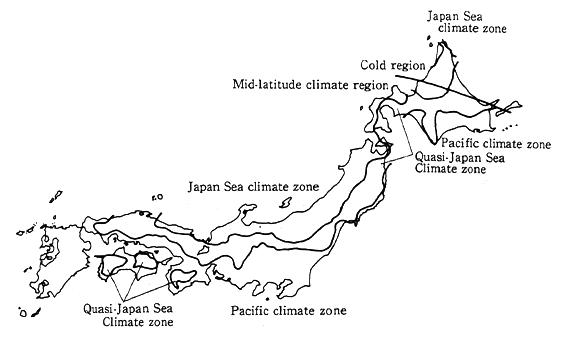
Source: Hideo Suzuki, 1962; Nakamura et. al., 1986
Reference : Comprehensive Report, the Third National Survey on the Natural Environment
In addition to the effects on the natural environment of such climatic changes as these, human activities may cause changes to environmental conditions. These changes, which include global warming and associated changes in precipitation, the increase in the amount of ultraviolet radiation due to the depletion of the ozone layer, and acid rain caused by air pollutants such as sulfuric and nitrous acids, may likewise affect the natural environment.
B. Vegetation and Man-made Surfaces
According to the results of the Third Survey on the Natural Environment as reported in 1988, regions covered with some kind of vegetation (natural vegetation, substitutional vegetation, planted forests, and agricultural land) account for 92.7% of Japan's land. Within that figure, forests cover 62.5% of Japan, which is high even for the world as a whole.
Natural vegetation, including natural forests and grasslands, is found in regions such as mountains, peninsulas, and remote islands that receive low human impact. Substitutional vegetation such as secondary forests and grasslands along with planted forests and farmland predominates in plains, hilly areas, and foothills. Areas lacking surface vegetation, such as streets and so on, are common in the vicinity of large cities. Areas with large amounts of natural vegetation are found only to a limited extent in Japan as a whole.
Natural vegetation preserved in its original shape is classified into the following five types : (1) natural vegetation in alpine zones such as creeping pine (Pinus Pumila) and alpine plants; (2) natural vegetation in the Vaccinio-Piceetea region such as Edomatsu (Picea jezoensis), Tomatsu (Abies sachalihensis), birches (Betula ermani), and Ooshirabiso (Abies mariesii) ; (3) natural vegetation in the Fagetea crenetea region such as beech (Fugus crenata) forests and Acer mono var-glarain-Tilia japonica community ;(4) natural vegetation in the Camellietea japonicae region such as oak forests; and (5) vegetation characteristic of watersides, wetlands, salt swamps, and sand dunes. Such areas account for 19.3% of Japan's land. An examination of the distribution of Japan's natural vegetation shows that 58.7% is found in Hokkaido; the rest is largely distributed in the Tohoku region, mountainous areas of the Tohoku and Chubu region, along the Japan Sea, and in the Okinawa Islands. The distribution of natural vegetation is extremely small in the Kinki, Chugoku, and Kyushu regions, amounting to not more than small areas scattered in the upper portions of mountains, peninsulas, and remote islands (Figure 4-5-2).
Fig. 4-5-2 Figures of Vegetation by Region
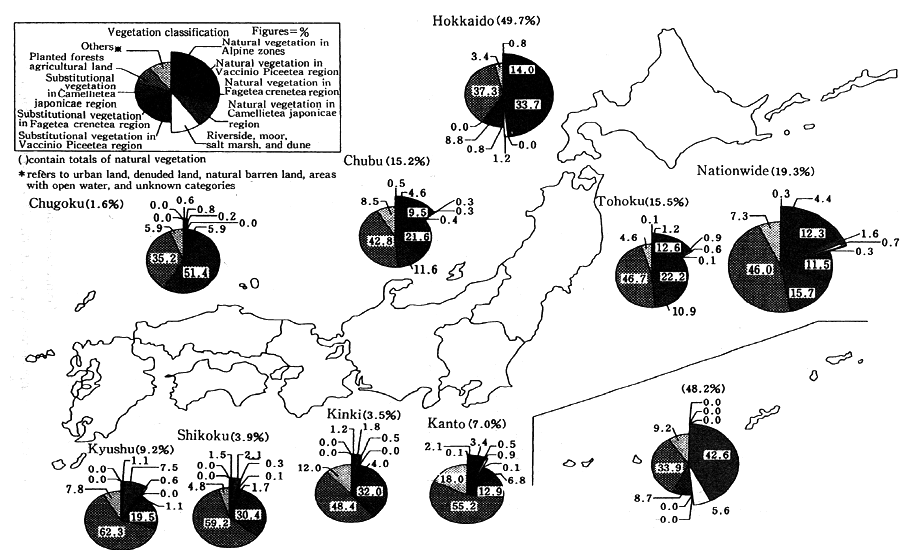
Reference : The Third National Survey on the Natural Environment, 1989
Vegetation changes with the passage of time to ultimately reach a stable state in the form of a climax ecosystem. Under Japan's climatic conditions, there are four representative types of climax vegetation: (1) evergreen broadleaf forests (laurilignosa trees) such as oak forests, which are widespread from the Nanseishoto islands in the south to the southern portion of the Tohoku region ; (2) deciduous broadleaf forests such as beech forests that are more common than mixed needleleaf and broadleaf forests in colder regions, which are found from the southern portion of Kyushu to the southern portion of Hokkaido; (3) mixed needleleaf and broadleaf forests, consisting of needleleaf trees such as Picea jezoensis and A bies sachalihensis as well as deciduous broadleaf trees such as mizunara oak (Quercus mongolica) ; and (4) subarctic needleleaf forests such as Picea jezoensis and Abies sachalihensis.
Regions of climax vegetation in which the natural vegetation of Japan predominates do exist ; however, there are not many such regions in Japan.
Fig. 4-5-3 Frequency Distribution of the Warmth Index for Highly Natural Types of Vegetation
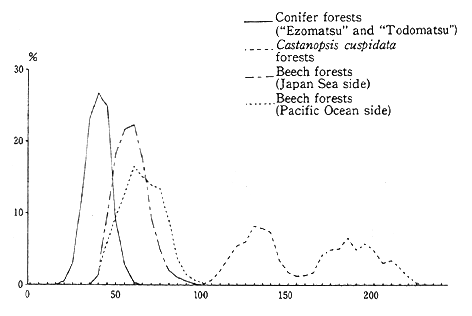
Reference : Comprehensive Report, the Third National Survey on the Natural Environment, 1989
Figure 4-5-3 shows the relationships between the natural vegetation characteristics of Japan and the climate (temperature indices are the Warmth Index and the Coldness Index). The period in which average monthly temperatures exceed 5 degree Cis considered hypothetically a period in which plant growth is possible, and months in which average monthly temperatures are lower than 5 degree C are considered periods of nongrowth. The Warmth Index is the total derived from the value of the average monthly temperature of months in which the average monthly temperature exceeds 5 degree C from which 5 degree Cis subtracted, and the value of the average monthly temperature of months in which the average monthly temperature is less than 5 degree C from which value 5 degree C is subtracted. The results of these calculations indicate that forests as typified by deciduous broadleaf trees are basically distributed in regions with warmth differences.
It is feared that the changes in temperature such as global warming cited in Section 1 of this chapter will have great impact on vegetation.
Figures of Vegetation by Region
According to the IPCC report, the average temperature is expected to rise by about 1 degree C by the year 2025 and by about 3 degree C by the end of the 21st century. If a rise of 1 degree C or 3 degree C is hypothesized under present conditions, current temperature indices of 69.4 [ degree C.month], which are Sapporo's climatic conditions and correspond to the southern limit of the current distribution of forests, would rise to 767[ degree C.month] by 2025 and to 927[ degree C.month] by the end of the 21st century. These conditions could be expected to have substantial effects on vegetation. For example, around 2025, Sapporo would leave the segment of the Warmth Index that supports the existence of ezomatsu and todomatsu forests and at the end of the 21st century would enter the segment of the Warmth Index that supports the existence of beech forests. Such temperature changes could be expected to differ depending on region and season and, as such, do not permit the drawing of simple conclusions; however, it is undeniable that global warming could have massive impacts on Japan' s vegetation.
An examination of the vegetation of Japan according to its degree of human disturbance suggests that forests, including primary, secondary, and planted forests, cover about two-thirds of Japan's territory.
Table 4-5-1 Frequency of Vegetation Appearance by Degree of Human Disturbance
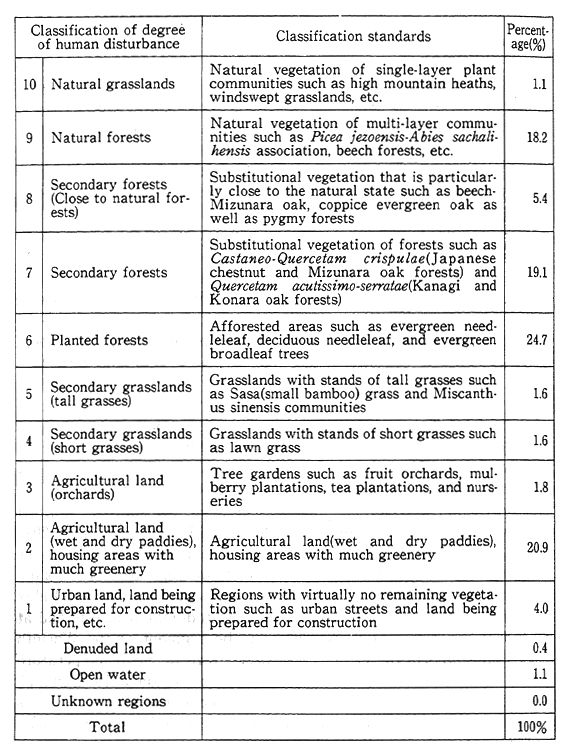
Reference: Vegetation Survey, the Second and Third National Survey on the Natural Environment
Plantations account for 24.7% of Japan's territory and are distributed widely throughout the country. More than half of Japan (53. 3%), including plantation, agricultural land, and urban areas, is covered by closely human-related vegetation. About one-fourth (26.7%) of the country consists of agricultural land, urban areas, and land being prepared for various uses (Table 4-5-1).
An examination of trends in vegetation reveals progressive declines in both the degree of human disturbance of the vegetation and the amount of such vegetation. Forests on the whole exhibit an increase of only + 0.2%, which is virtually unchanged ; however a closer look shows a decrease of 3.9% in natural and secondary forests combined and an increase of 4.1% in afforested areas. This suggests that a substantial portion of natural and secondary forests is changing into planted forests. At the same time, while agricultural land showed a decrease of 1. 8%, urban areas increased by 1.5% (Table 4-5-2). Examining Japan's vegetation as a whole, forests are gradually declining in terms of the degree of human disturbance while urban areas where not much is seen are increasing.
Table 4-5-2 Changes in Vegetation by Degree of Human Disturbance
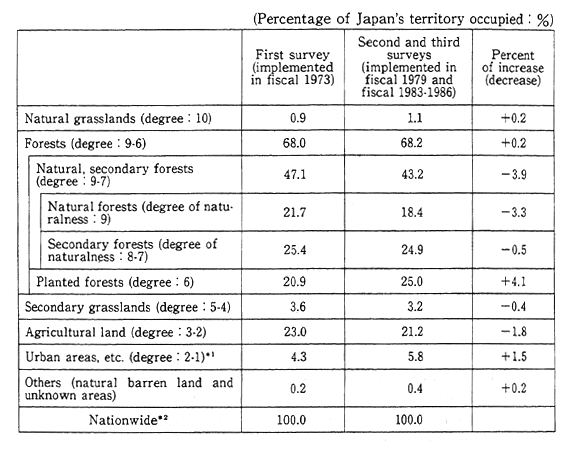
Notes
* 1 : Urban areas include residential areas with much greenery
* 2 : Does not include areas of open water. Note that in the comparison of the results of the second and third surveys with those of the first, proportions of the national territory and the ensuing increases or decreases wer ecalculated without including open water areas because the first survey excided such areas. It should be noted that the proportions expressed in Table4-5-1 and in this table are different in regard to the results of the second and third surveys.
Reference: Environment Agency: Vegetation Survey, Natural Surveys on the Natural Environment
Secondary forests, afforested lands, and agricultural lands predominate in plain and hilly areas that are located near areas of human activity. Secondary forests such as Mizunara oak forests in Fagetea crenetae zones (beech zones), forests consisting of Konara oak (Quercus serrata) and Kanugi oak (Quercus acutissima) in Camellietea japonicae zones (camellia zones), pine (Pinus spp.) forests, and Coppice evergreen oak forests. Most of these secondary forests are maintained for human activities for life such as the gathering of wood for charcoal and the gathering of fallen leaves for use as fertilizer. This type of woodlands is used as convenient and sustainable nature resources that are intimately connected with people's daily lives. Nonetheless, the role of secondary forests which are sustained by human activity is gradually changing due to a sharp decrease in human activity in such forests,, reflecting the declining needs for these forests as resources and also the depopulation of the countryside.
On the other hand, artificial surfaces (urban areas, etc.), consisb ing of houses, buildings, factories, and other structures, increased from 4.3% to 5.8%, a rise of 1.5%, in the same time span. Man-made surfaces are a disturbing factor in the natural circulation of substances in nature. For example, forests have a capacity of absorption some 20 times that of sidewalks. It is much more difficult for man-made surfaces to absorb rainwater than for forests. And, another example, trees help to prevent warming by consuming the heat of vaporization that results as a byproduct of evaporation, help to prevent aridification by releasing, at the same time, moisture into the air, and provide a number of other useful functions such as absorbing noise and pollutants.
Man-made surfaces, scarce in trees, have few such capabilities. Man-made surfaces tend to be warmer and drier than the surrounding climate would warrant because they emit man-made heat as the result of human activities. Therefore, there is some concern that such surfaces may also have effects on Japan's natural environment.
Fig. 4-5-4 Boundary Lines for Animal Distributions in Japan
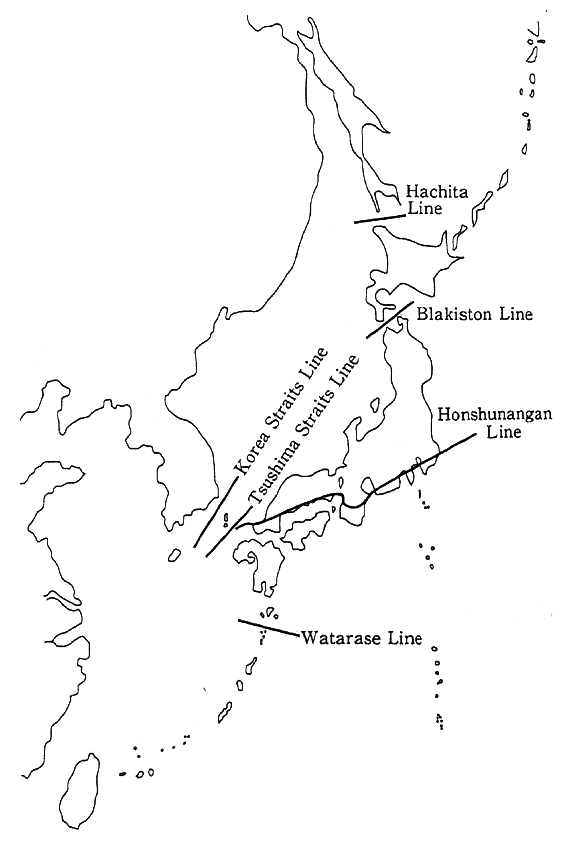
Source: Kawai et. al., 1980
Reference : Comprehensive Report, the Third National Survey on the Natural Environment, 1989
Fig. 4-5-5 Breakdown of Vegetation by Data on Animal Habitats
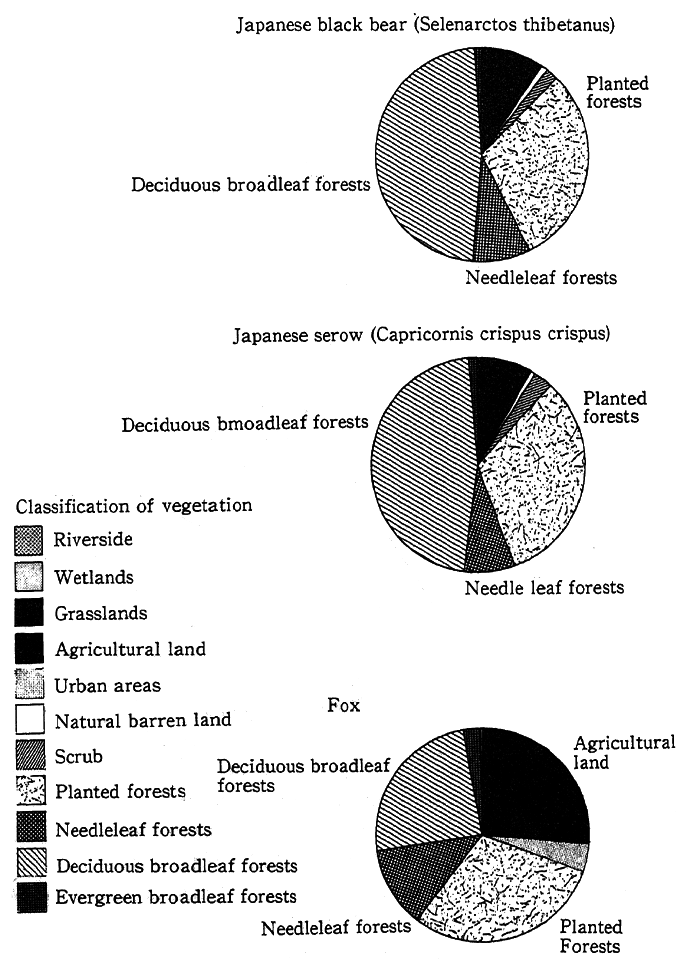
Note: The analysis was conducted by mesh units. Therefore, it is necessary to interpret the statement "The various species' habitats were easily verified because of the various types of vegetation in most of the areas observed." For example, it is necessary to interpret "habitats were verified in agricultural land" as meaning "habitats were easily verified in most of the agricultural land observed."
Reference : Comprehensive Report, the Third National Survey on the Natural Environment
Fig. 4-5-6 Distribution of Butterfly Varieties and Tempera ture Indices
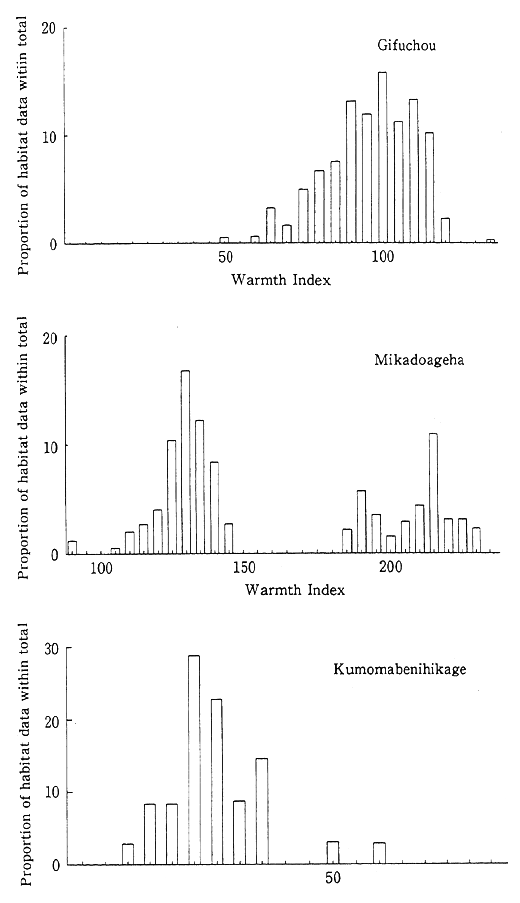
Reference : Comprehensive Report, the Third National Survey on the Natural Environment. 1989
C. Fauna
The distribution of animals, elements of the ecosystem, is subject to the characteristics indigenous to the Japanese islands, which reflect geographical, climatic, and vegetation conditions. Some boundary lines that demarcate the fauna are known, such as the Blakiston line that separates Hokkaido from H onshu and the Watarase line that separates the Yaku Islands and the Amami Islands. If the nine representative medium-sized and large mammals are classified into three distribution patterns demarcated by the Blakiston line, then the Japanese brown bear is the only one whose distribution is limited to Hokkaido; those whose distribution is in Honshu and southward include the Japanese black bear, the Japanese serow, the Japanese monkey, the Japanese wild boar, and the Japanese badger. Those whose distribution is in both areas include the Japanese fox, the raccoon, and the Japanese deer (Figure 4-5-4).
Vegetation has a great effect on animals' living conditions as it provides food and shelter. Therefore, there is a close relationship between vegetation and animals. Figure 4-5-5 shows a breakdown of vegetation according to data on the living patterns of mammals. For example, it provides confirmation that the Japanese black bear and the Japanese serow tend to live in deciduous broadleaf forests, especially in beech forests, and the fox tends to live in agricultural lands and Kanugi oak and Konara oak forests.
Climate also has great effects on animal habitats. A telling illustration is provided by a comparison of the previously mentioned Warmth Index with the distribution of butterflies, which reveals that the habitats of Kumabenihikage (Erebia ligea), Gifuchou (Luelidorfia japonica), and Mikadoageha (Graphium dosan) butterflies are closely related to factors determined by vegetation and especially to temperature (Figure 4-5-6). It suggests that climatic changes induced by global warming could have far-reaching effects on the lives of animals, just as on plant life.